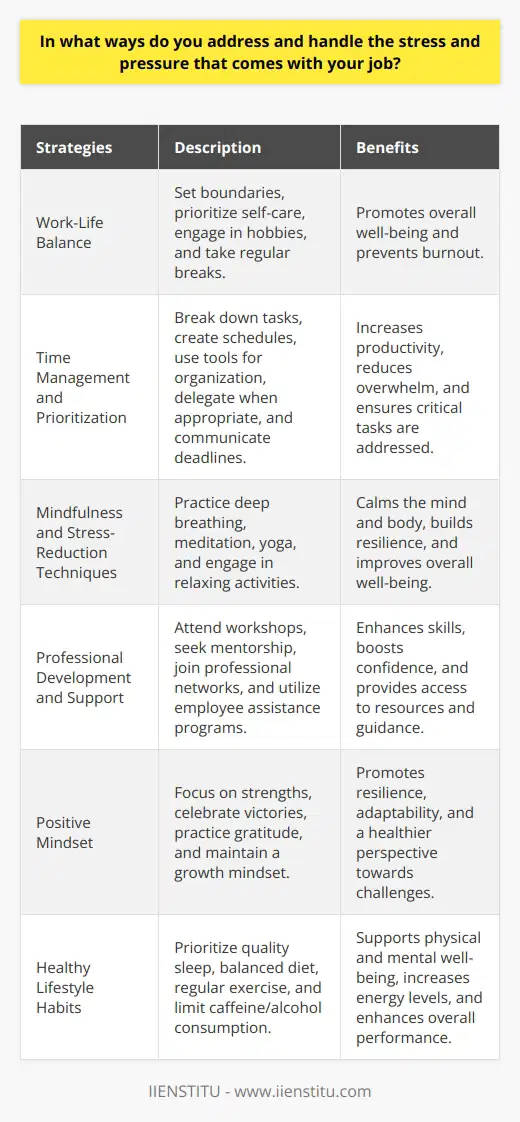
In the world of business and leadership, managing a team is often considered a challenging task. But have you ever been faced with the responsibility of managing a stressed team? This question frequently arises in interviews, particularly at a mid to senior-level position.
Related Course: Leadership Development Course
Hiring managers are keen to understand your ability to handle difficult situations and ensure the well-being of your team members. In this article, we will delve into the purpose of this interview question, the expected answers, and some key factors to consider when responding.
So, let's explore the realm of managing stressed teams and how to tackle this question with confidence.
Why Is This Interview Question Asked: Have You Managed a Stressed Team?
The primary reason behind asking this interview question is to assess your leadership skills and your ability to navigate challenging situations. In today's fast-paced and competitive work environment, stress is an inevitable factor.
It can impact both individuals and teams, leading to decreased morale, productivity, and overall team dynamics. Therefore, organizations are seeking leaders who can effectively manage and support their team through stressful periods.
By asking this question, interviewers aim to gauge your experience, approach, and strategies in handling such circumstances.
The Purpose of the Question
The purpose of asking whether you have managed a stressed team is to gain insights into your leadership effectiveness, problem-solving abilities, and emotional intelligence. Managing a team under stress requires a unique set of skills. It involves understanding the root causes of stress, providing support, and implementing strategies to alleviate stress levels. The interviewer wants to determine your level of experience and expertise in handling these complex issues, as well as your ability to maintain a positive and productive team environment amidst pressure.
At What Interview Level Is It Asked?
This question is usually asked at mid to senior-level positions where leadership and management abilities are crucial for success. Roles such as team leads, managers, supervisors, and directors may encounter situations where their teams are under immense stress. Therefore, employers particularly want to evaluate candidates for these positions to ensure they have the necessary skills to lead and support their team through challenging times.
What Kind of Answer Is Expected from the Candidate?
When answering this question, the candidate is expected to provide a detailed and comprehensive response. It is important to demonstrate your experience in managing stressed teams by sharing specific examples from your past roles.
The interviewer wants to hear about your approach to identifying stress factors, how you support your team members, and the strategies you implement to alleviate stress levels. Your answer should showcase your ability to remain calm and composed during stressful situations and your capability to effectively communicate and motivate your team.
Possible Answers to Consider
Share a specific example: Begin by sharing a real-life scenario where you managed a stressed team. Describe the context, the challenges faced, and the actions you took to alleviate stress levels. Highlight the outcomes and the positive impact your leadership had on the team.
Emphasize your communication skills: Effective communication is vital when managing a stressed team. Discuss how you maintained open lines of communication, actively listened to team members' concerns, and provided timely feedback and support.
Showcase your problem-solving abilities: Managing a stressed team requires a proactive approach to problem-solving. Explain how you identified the root causes of stress, implemented strategies to address them, and made necessary adjustments to workflow or processes to improve the team's overall well-being.
Demonstrate your empathy and emotional intelligence: Managing stress requires empathy and understanding. Illustrate how you showed compassion towards your team members, acknowledged their emotions, and created a supportive environment in which they felt valued and cared for.
What to Consider When Answering
When responding to this question, keep the following in mind:
Be specific and provide details: Use specific examples and anecdotes to make your answer more compelling. Include details about the team, the stress factors, and the outcomes achieved through your leadership.
Focus on teamwork and collaboration: Highlight how you encouraged collaboration and teamwork within the stressed team. Explain how fostering a sense of unity and support helped the team overcome challenges together.
Emphasize your ability to manage emotions: Managing a stressed team also involves managing your own emotions. Showcase your emotional intelligence by explaining how you remain calm, composed, and positive, even in high-pressure situations.
Highlight your commitment to employee well-being: Articulate how you prioritize your team members' well-being and work-life balance. Mention any initiatives or programs you implemented to support their mental and emotional health.
In conclusion, managing a stressed team is a significant responsibility that requires strong leadership skills, empathy, and problem-solving abilities. By answering this interview question effectively, you can demonstrate your capability to handle challenging situations and ensure the success and well-being of your team members.
Remember to provide specific examples, focus on effective communication, showcase problem-solving skills, and highlight your empathy and emotional intelligence. With a well-thought-out answer, you can leave a lasting impression as a candidate who has the expertise and experience in managing stressed teams.
Causes of stress within the team
Impact of stress on team performance
Strategies used to alleviate stress within the team
Similar interview questions:
Yes/No: Would you say you have experience in leading a team that faced high levels of stress?
Single-word answer: Have you ever supervised a team under significant stress?
Multiple-choice: When faced with a team in a stressful situation, which of the following strategies have you used to manage the situation?
a) Team-building exercises and morale-boosting activities
b) Regular check-ins with team members to address concerns and provide support
c) Implementing stress reduction techniques, such as mindfulness or meditation
d) Collaborating with team members to develop a comprehensive action planRank in order of preference: If you have led a stressed team before, please rank the following approaches based on their effectiveness in managing and reducing stress levels:
a) Encouraging open communication and fostering trust within the team
b) Providing clear guidance and realistic expectations to team members
c) Offering opportunities for professional development and skill-building
d) Allocating resources to ensure sufficient support and assistance for the teamOpen-ended response: Describe a situation where you successfully managed a team that was dealing with high levels of stress. What steps did you take to address the stress and help the team perform effectively?
Fill in the blank: In your experience, ________ has been a key factor in effectively managing teams that are under stress.
True/False: Managing a team under stress requires a different skill set compared to managing a team under normal working conditions.
Short answer: How do you approach team members who are exhibiting signs of stress or burnout?
Agree/Disagree: Taking preemptive measures to enhance the overall well-being of team members can prevent stress from negatively impacting team performance.
Long answer: Please provide an overview of the steps you follow to identify and address potential stressors within a team, as well as the strategies you employ to ensure the team's resilience in high-pressure situations.
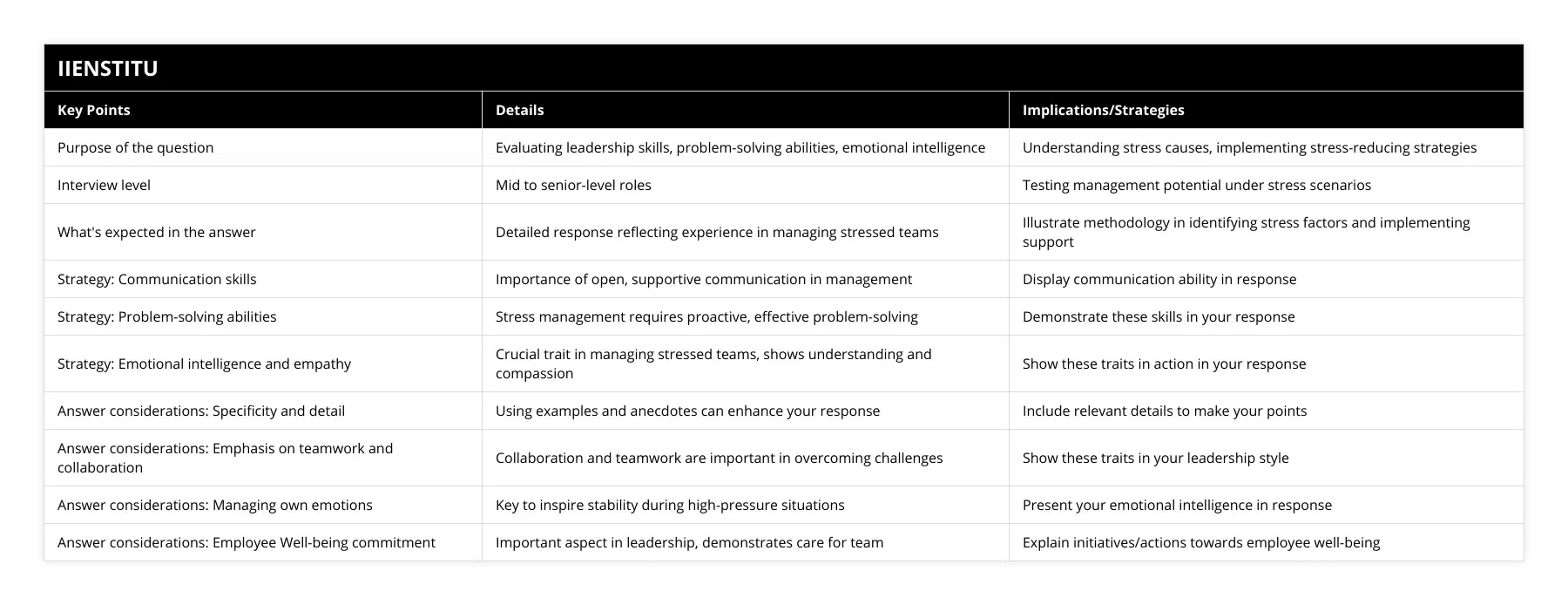
Frequently Asked Questions
How do you approach managing a team that is under a lot of stress?
Managing a team under stress requires a multifaceted approach that prioritizes communication, support, and strategic planning. Effective leaders must first recognize the signs of stress within their team and address them proactively. This involves creating an open and transparent environment where team members feel comfortable expressing their concerns and challenges.
Foster Open Communication
Encourage regular check-ins with team members to gauge their well-being and identify potential stressors. Listen actively and empathetically to their concerns, and work collaboratively to find solutions. Create a safe space for honest feedback and suggestions, and be receptive to their ideas for improving the work environment.
Prioritize Self-Care and Work-Life Balance
Promote a culture that values self-care and work-life balance. Encourage team members to take breaks, prioritize their mental health, and engage in stress-reducing activities. Lead by example and model healthy behaviors, such as taking time off when needed and maintaining boundaries between work and personal life.
Provide Resources and Support
Offer resources and support to help team members manage stress effectively. This may include access to mental health professionals, stress management workshops, or employee assistance programs. Ensure that team members are aware of these resources and feel comfortable utilizing them when needed.
Optimize Workload and Expectations
Assess the team's workload and expectations regularly to ensure they are realistic and achievable. Prioritize tasks and projects based on their importance and urgency, and allocate resources accordingly. Be willing to adjust deadlines or redistribute responsibilities when necessary to alleviate excessive pressure on individual team members.
Foster a Supportive Team Environment
Encourage a supportive and collaborative team environment where members feel valued and appreciated. Celebrate successes, acknowledge individual contributions, and provide constructive feedback to help team members grow and develop. Foster a sense of camaraderie and teamwork, and encourage team members to support and assist one another during challenging times.
Continuously Evaluate and Adapt
Regularly assess the effectiveness of stress management strategies and be open to making adjustments as needed. Seek feedback from team members and be proactive in addressing any new or persistent stressors. Continuously monitor the team's well-being and performance, and adapt your approach as necessary to ensure their long-term success and resilience.
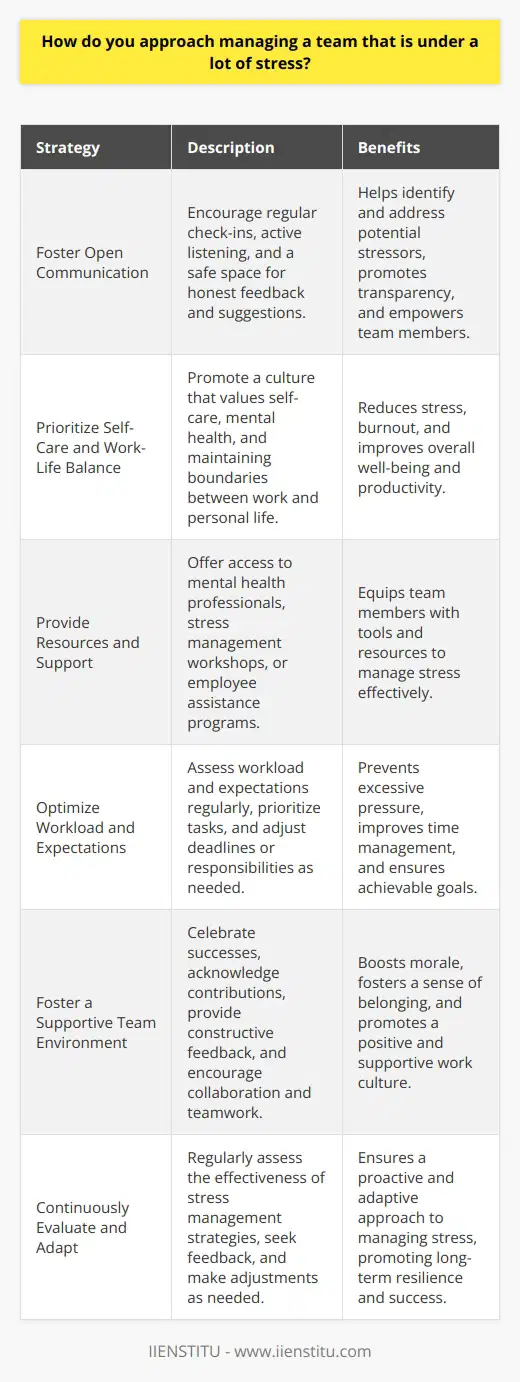
What strategies have you used in the past to help alleviate stress within your team?
In the past, I have employed several strategies to help alleviate stress within my team. One effective approach has been to foster open communication and encourage team members to share their concerns and challenges. By creating a safe and supportive environment, individuals feel more comfortable discussing their stress levels and seeking assistance when needed. Regular check-ins and one-on-one meetings have proven valuable in identifying and addressing potential stressors before they escalate.
Prioritizing Self-Care and Work-Life Balance
Another critical strategy for reducing team stress is to prioritize self-care and work-life balance. Encouraging team members to take regular breaks, disconnect from work during non-work hours, and engage in stress-reducing activities such as exercise, meditation, or hobbies can significantly improve their overall well-being. Leading by example and modeling healthy habits can inspire team members to adopt similar practices and create a culture that values self-care.
Providing Resources and Support
Offering resources and support to team members is essential for managing stress effectively. This may include access to employee assistance programs, mental health resources, or stress management workshops. By equipping team members with the tools and knowledge to cope with stress, they are better prepared to navigate challenging situations and maintain their well-being.
Encouraging Collaboration and Teamwork
Fostering a collaborative and supportive team environment can also help alleviate stress. Encouraging team members to work together, share responsibilities, and support one another can create a sense of camaraderie and reduce feelings of isolation or overwhelm. Celebrating successes, acknowledging contributions, and promoting a positive team dynamic can boost morale and resilience in the face of stress.
Regularly Assessing and Adjusting Workload
Finally, regularly assessing and adjusting workload is crucial for managing team stress. Monitoring project timelines, deadlines, and individual workloads can help identify potential stress points and allow for proactive adjustments. Redistributing tasks, providing additional resources, or adjusting priorities when necessary can prevent team members from becoming overburdened and stressed.
By implementing these strategies consistently and with a genuine commitment to employee well-being, leaders can effectively alleviate stress within their teams and create a more positive and productive work environment.
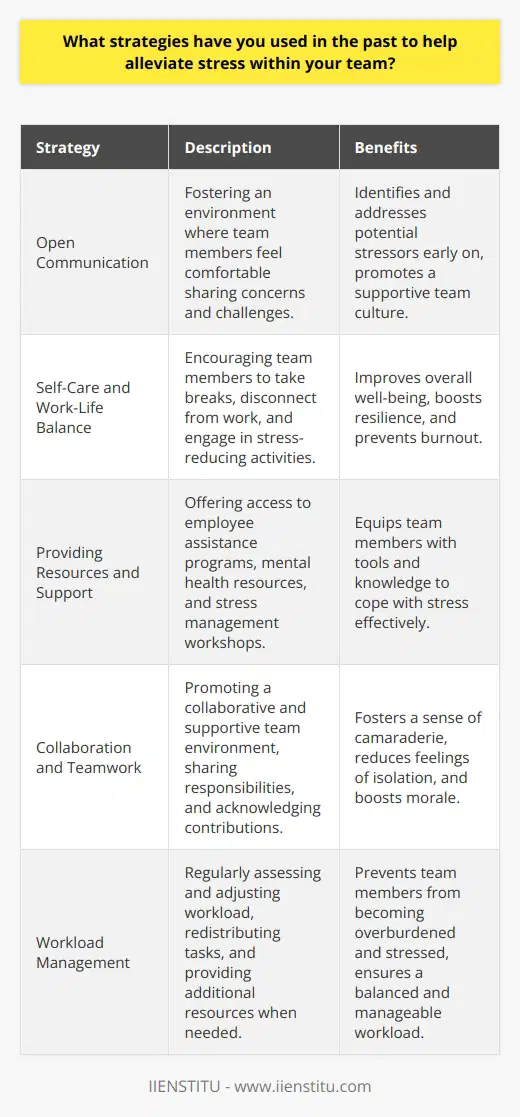
Can you describe a specific situation where you successfully managed a stressed team and what the outcome was?
In a previous role as a project manager, I encountered a situation where my team was under immense pressure to deliver a complex software solution within a tight deadline. The client had made several last-minute changes to the project scope, causing significant stress and uncertainty among team members. To manage this situation effectively, I implemented a multi-faceted approach that focused on clear communication, prioritization, and team support.
Establishing Clear Communication Channels
I recognized that transparent and frequent communication was crucial to alleviate the team's stress levels. I scheduled daily stand-up meetings to provide updates, discuss challenges, and ensure everyone was aligned on priorities. Additionally, I maintained an open-door policy, encouraging team members to voice their concerns and share their ideas. By fostering open communication, I created an environment where the team felt heard and supported.
Prioritizing Tasks and Managing Expectations
To address the increased workload and tight deadline, I worked closely with the team to prioritize tasks based on their impact and urgency. We broke down the project into smaller, manageable milestones and set realistic expectations with the client. By focusing on the most critical aspects of the project and communicating progress regularly, we were able to manage the client's expectations and reduce the pressure on the team.
Providing Support and Resources
I recognized that the team needed additional support to navigate the challenging situation. I arranged for extra resources, such as bringing in a senior developer to provide guidance and technical expertise. I also organized stress-management workshops and encouraged the team to take short breaks to recharge. By demonstrating empathy and providing the necessary resources, I helped the team maintain their well-being and productivity.
Celebrating Milestones and Successes
Throughout the project, I made sure to acknowledge and celebrate the team's progress and achievements. We held regular team meetings to recognize individual contributions and highlight key milestones. By celebrating successes along the way, I boosted morale and reinforced the team's sense of accomplishment, even in the face of adversity.
Outcome and Lessons Learned
Despite the initial challenges, the team successfully delivered the software solution on time, meeting the client's expectations. The experience taught me the importance of effective communication, adaptability, and prioritization in managing a stressed team. By fostering a supportive and collaborative environment, we were able to overcome obstacles and achieve our goals.
In conclusion, successfully managing a stressed team requires a combination of clear communication, prioritization, support, and recognition. By implementing these strategies, leaders can help their teams navigate challenging situations, maintain productivity, and deliver positive outcomes.
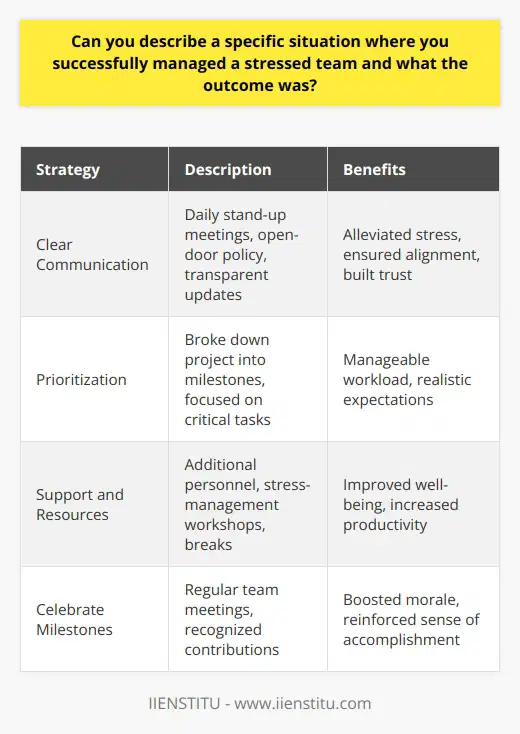
How have you managed a stressed team in the past?
Managing a stressed team requires a multifaceted approach that addresses both individual and collective needs. As a leader, I have employed various strategies to support my team during challenging times. First and foremost, I prioritize open and transparent communication. By creating a safe space for team members to express their concerns and feelings, I can better understand the sources of their stress and work collaboratively to find solutions.
Promoting Work-Life Balance
I strongly believe in the importance of promoting a healthy work-life balance. When team members are overwhelmed, I encourage them to take breaks, prioritize self-care, and set boundaries between their professional and personal lives. This may involve adjusting workloads, offering flexible schedules, or providing resources for stress management techniques such as meditation or exercise.
Fostering a Supportive Team Environment
Fostering a supportive team environment is crucial in managing stress. I actively encourage team members to help one another, share knowledge, and collaborate on projects. By promoting a culture of empathy and understanding, team members feel more connected and less isolated in their struggles. Regular team-building activities and opportunities for social interaction can also help alleviate stress and improve morale.
Providing Resources and Support
As a manager, it is my responsibility to provide my team with the resources and support they need to succeed. This includes offering training and development opportunities to help them acquire new skills and grow professionally. I also make sure to recognize and celebrate their achievements, no matter how small, to boost their confidence and motivation.
Leading by Example
Finally, I believe in leading by example. I strive to maintain a positive attitude, even in the face of adversity, and demonstrate healthy coping mechanisms for dealing with stress. By modeling resilience and adaptability, I inspire my team to do the same. I also make a point to prioritize my own well-being, as I cannot effectively support others if I am not taking care of myself.
In summary, managing a stressed team requires a combination of open communication, promoting work-life balance, fostering a supportive environment, providing resources, and leading by example. By implementing these strategies, I have successfully helped my team navigate challenging times and emerge stronger and more resilient.
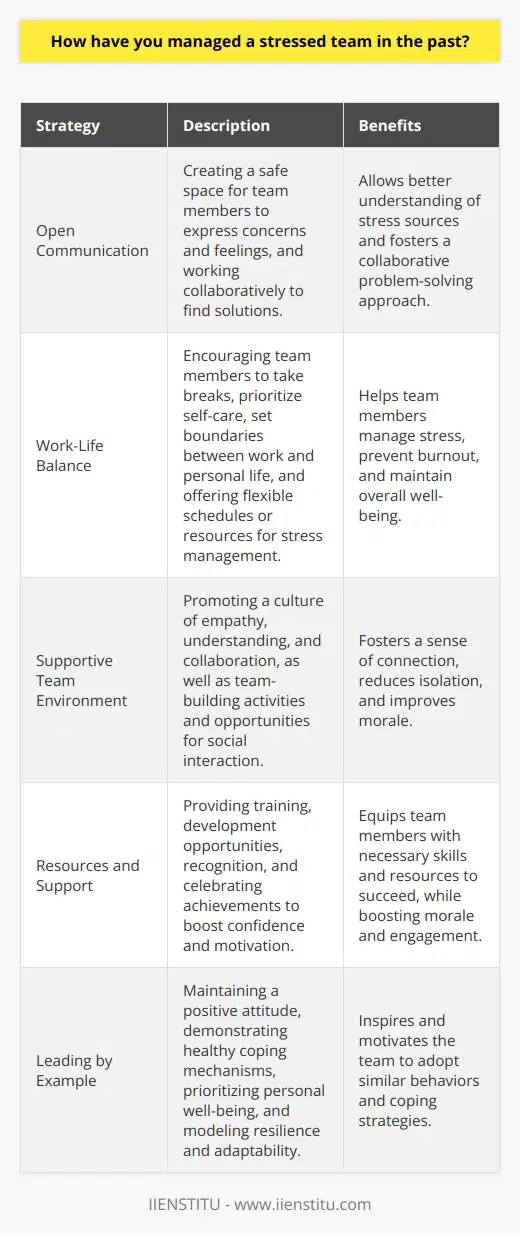
What strategies do you employ to alleviate stress within your team?
Stress management is a critical aspect of team leadership, as it directly impacts employee well-being and productivity. Implementing effective strategies to alleviate stress within a team is essential for maintaining a healthy and efficient work environment. This paragraph explores various approaches that can be employed to manage and reduce stress among team members.
Promoting Open Communication
One of the most important strategies for alleviating stress within a team is fostering open communication. Encouraging team members to express their concerns, challenges, and ideas openly helps create a supportive and collaborative atmosphere. Regular check-ins, one-on-one meetings, and team discussions provide opportunities for employees to voice their thoughts and receive guidance and support from their manager and peers.
Encouraging Work-Life Balance
Promoting a healthy work-life balance is crucial for reducing stress levels among team members. Encouraging employees to take regular breaks, disconnect from work after hours, and prioritize self-care activities can significantly improve their overall well-being. Managers should lead by example, demonstrating the importance of maintaining boundaries between work and personal life and respecting team members' time off.
Providing Resources and Support
Offering resources and support to help team members manage stress is another effective strategy. This can include access to employee assistance programs, stress management workshops, or mental health resources. Providing tools and technologies that streamline processes and reduce workload can also contribute to reducing stress levels. Additionally, offering flexibility in work arrangements, such as remote work options or flexible schedules, can help employees better manage their personal and professional responsibilities.
Cultivating a Positive Work Environment
Creating a positive and supportive work environment is essential for alleviating stress within a team. Recognizing and celebrating team members' achievements, promoting a culture of gratitude, and encouraging positive interactions among colleagues can boost morale and reduce stress. Managers should also address any conflicts or negative dynamics promptly and fairly to maintain a healthy team atmosphere.
Encouraging Self-Care and Stress Management Techniques
Promoting self-care and stress management techniques among team members is another important strategy. Encouraging employees to engage in regular exercise, practice mindfulness or meditation, and prioritize sleep and nutrition can help them better cope with stress. Managers can also organize team-building activities or workshops that focus on stress reduction and resilience-building skills.
Monitoring Workload and Capacity
Closely monitoring team members' workload and capacity is crucial for preventing burnout and excessive stress. Managers should regularly assess individual and team workloads, ensuring that tasks are distributed fairly and that employees have the resources and support needed to complete their work effectively. Identifying and addressing any bottlenecks or inefficiencies in processes can also help alleviate stress and improve overall team performance.
By implementing these strategies, managers can create a work environment that prioritizes employee well-being and effectively manages stress within their team. Promoting open communication, encouraging work-life balance, providing resources and support, cultivating a positive work environment, encouraging self-care and stress management techniques, and monitoring workload and capacity are all essential approaches to alleviating stress and fostering a healthy and productive team dynamic.

Can you describe a situation where you successfully led a team through a stressful period?
Leading a team through a stressful period requires effective communication, adaptability, and a clear focus on goals. In one such situation, I successfully guided my team through a challenging project with a tight deadline. By implementing several key strategies, we were able to overcome obstacles and deliver exceptional results.
Establishing Clear Communication Channels
I recognized that open and transparent communication was crucial to navigating the stressful period. I scheduled regular team meetings to discuss progress, challenges, and concerns. These meetings provided a platform for team members to voice their opinions and offer solutions. I also made myself available for one-on-one conversations to address individual concerns and provide support.
Prioritizing Tasks and Setting Milestones
To manage the workload effectively, I worked with the team to prioritize tasks based on urgency and importance. We broke down the project into smaller, manageable milestones. This approach allowed us to track progress and celebrate small victories along the way. By setting clear expectations and deadlines, we maintained focus and motivation throughout the stressful period.
Fostering a Supportive Team Environment
I recognized that a supportive team environment was essential to managing stress and maintaining productivity. I encouraged team members to help each other and share their expertise. We celebrated individual and team successes, no matter how small. I also organized team-building activities to boost morale and strengthen relationships. These efforts created a positive and collaborative atmosphere that helped us overcome challenges together.
Leading by Example and Maintaining Composure
As a leader, I understood the importance of leading by example and maintaining composure under pressure. I remained calm and focused, even in the face of setbacks. I demonstrated a positive attitude and a willingness to adapt to changing circumstances. By modeling resilience and determination, I inspired my team to persevere and maintain their commitment to the project.
Encouraging Self-Care and Work-Life Balance
I recognized that the stressful period could take a toll on my team's well-being. I encouraged team members to prioritize self-care and maintain a healthy work-life balance. We discussed strategies for managing stress, such as taking short breaks, practicing mindfulness, and engaging in physical activity. By promoting a culture of self-care, we were able to maintain our energy and focus throughout the challenging period.
Conclusion
Leading a team through a stressful period requires a combination of effective communication, adaptability, and a focus on well-being. By establishing clear communication channels, prioritizing tasks, fostering a supportive environment, leading by example, and encouraging self-care, I successfully guided my team through a challenging project. The experience strengthened our resilience, teamwork, and ability to deliver exceptional results under pressure.
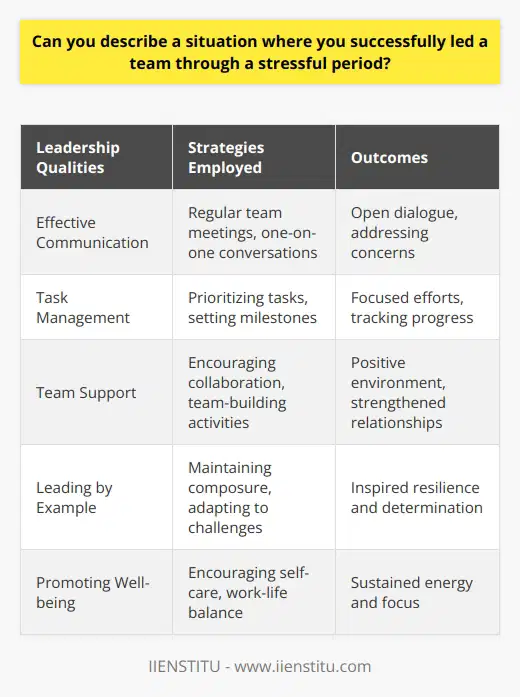
How do you typically deal with stress and pressure?
Stress and pressure are inevitable aspects of life that everyone encounters at some point. Dealing with these challenges effectively is crucial for maintaining mental and physical well-being. There are various strategies that individuals typically employ to manage stress and pressure in their lives.
Identifying Stressors
The first step in dealing with stress is to identify the sources of stress in one's life. This may include work-related pressures, personal relationships, financial concerns, or health issues. Once the stressors are recognized, it becomes easier to develop a plan to address them.
Time Management
Effective time management is a key strategy for reducing stress and pressure. By prioritizing tasks, setting realistic goals, and allocating sufficient time for each activity, individuals can avoid feeling overwhelmed. Breaking down large projects into smaller, manageable steps can also help alleviate stress.
Creating a Schedule
Developing a daily or weekly schedule can help individuals stay organized and focused. This schedule should include time for work, leisure activities, exercise, and rest. Sticking to a routine can provide a sense of structure and control, which can reduce stress levels.
Relaxation Techniques
Engaging in relaxation techniques is another common way to deal with stress and pressure. These techniques can help calm the mind, reduce tension, and promote a sense of well-being. Some popular relaxation methods include:
Deep Breathing
Taking slow, deep breaths can help reduce stress and anxiety. This simple technique can be done anywhere and at any time. Focus on inhaling deeply through the nose and exhaling slowly through the mouth.
Meditation
Meditation involves focusing the mind on the present moment and letting go of distracting thoughts. Regular meditation practice can help reduce stress, improve concentration, and promote emotional balance. There are various types of meditation, such as mindfulness meditation and guided imagery.
Progressive Muscle Relaxation
This technique involves systematically tensing and relaxing different muscle groups in the body. Start by tensing the muscles in the feet, hold for a few seconds, then release. Gradually work up the body, tensing and relaxing each muscle group.
Exercise and Physical Activity
Engaging in regular exercise and physical activity is an effective way to reduce stress and pressure. Exercise releases endorphins, which are natural mood-boosters. It also helps improve sleep quality, increase energy levels, and enhance overall well-being. Aim for at least 30 minutes of moderate exercise most days of the week.
Social Support
Having a strong support system is crucial for managing stress and pressure. Talking to friends, family members, or a therapist can provide a sense of connection and help individuals gain new perspectives on their challenges. Joining support groups or participating in social activities can also help reduce stress and promote a sense of belonging.
Conclusion
Dealing with stress and pressure is an ongoing process that requires a combination of strategies. By identifying stressors, managing time effectively, practicing relaxation techniques, engaging in regular exercise, and seeking social support, individuals can develop resilience and improve their ability to cope with life's challenges. Remember, everyone experiences stress differently, so it's important to find the methods that work best for you.
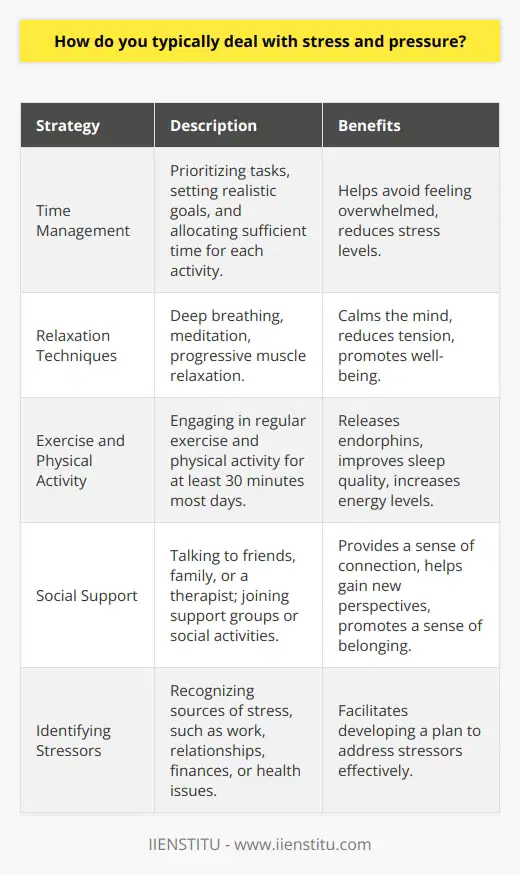
What strategies have you found most effective in managing stress and pressure?
Effective stress management strategies vary from person to person, but some proven techniques can help individuals cope with pressure. One of the most important strategies is regular exercise, which releases endorphins and reduces stress hormones. Engaging in physical activity, such as jogging, swimming, or yoga, can significantly improve mood and reduce anxiety. Additionally, practicing mindfulness and meditation can help individuals focus on the present moment and reduce stress. Deep breathing exercises and progressive muscle relaxation are also effective in calming the mind and body.
Time Management and Organization
Another crucial aspect of managing stress is effective time management and organization. Creating a schedule and prioritizing tasks can help individuals feel more in control of their lives. Breaking large projects into smaller, manageable tasks can also reduce overwhelm and increase productivity. Setting realistic goals and expectations is important, as trying to accomplish too much can lead to burnout. Learning to say no to non-essential tasks and delegating responsibilities when possible can also help reduce stress levels.
Self-Care and Social Support
Engaging in self-care activities is essential for managing stress and pressure. This includes getting enough sleep, eating a healthy diet, and taking breaks when needed. Pursuing hobbies and interests outside of work or school can also provide a sense of balance and enjoyment. Building a strong support system of friends, family, or professionals can provide a valuable outlet for discussing concerns and receiving encouragement. Talking to others who have experienced similar challenges can also provide perspective and coping strategies.
Cognitive Restructuring and Positive Self-Talk
Cognitive restructuring involves identifying and challenging negative thought patterns that contribute to stress and anxiety. By reframing situations in a more positive light and focusing on solutions rather than problems, individuals can reduce stress levels. Engaging in positive self-talk and affirmations can also help build resilience and confidence. Celebrating small victories and acknowledging progress can provide motivation and reduce feelings of overwhelm.
Professional Help and Resources
If stress and pressure become unmanageable, seeking professional help from a therapist or counselor can be beneficial. They can provide additional coping strategies and support tailored to individual needs. Many workplaces and schools also offer stress management resources, such as workshops, support groups, and employee assistance programs. Taking advantage of these resources can provide valuable tools and support for managing stress and pressure effectively.
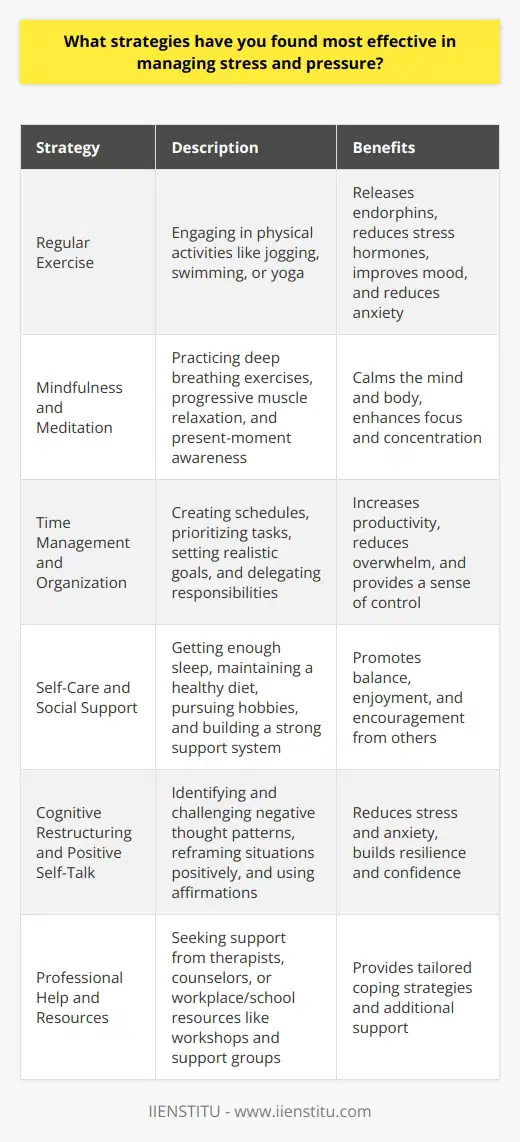
When faced with a high-pressure situation, how do you maintain your composure and handle the stress?
Maintaining composure and handling stress in high-pressure situations is a crucial skill for personal and professional success. Individuals who can effectively manage their emotional responses and remain focused under pressure are more likely to make sound decisions and achieve their goals. Several strategies can be employed to cultivate this ability and mitigate the negative effects of stress.
Preparation and Planning
One of the most effective ways to maintain composure in high-pressure situations is through adequate preparation and planning. By anticipating potential challenges and developing contingency plans, individuals can reduce uncertainty and increase their confidence in their ability to handle stressful events. This proactive approach allows for a more measured and rational response when faced with pressure.
Mental Rehearsal
Engaging in mental rehearsal, or visualizing oneself successfully navigating a high-pressure situation, can also enhance composure. By mentally practicing their response to stress, individuals can train their minds to remain calm and focused when faced with real-life challenges. This technique helps to develop a sense of familiarity and control, reducing the impact of stress on performance.
Mindfulness and Relaxation Techniques
Incorporating mindfulness and relaxation techniques into daily life can significantly improve an individual's ability to maintain composure under pressure. Practices such as deep breathing, meditation, and progressive muscle relaxation help to reduce physiological arousal and promote a state of mental clarity and emotional balance. By regularly engaging in these activities, individuals can develop a greater capacity for stress resilience.
Cognitive Reframing
Cognitive reframing involves altering one's perspective on a stressful situation to view it as a challenge rather than a threat. By adopting a growth mindset and focusing on the opportunities for learning and development, individuals can reduce the emotional impact of high-pressure situations. This shift in thinking allows for a more adaptive and proactive response to stress.
Support Systems
Cultivating a strong support system of trusted colleagues, friends, and family members can provide a valuable resource for managing stress. Sharing concerns and seeking guidance from others can offer new perspectives and help to reduce the emotional burden of high-pressure situations. Additionally, engaging in regular physical exercise and maintaining a balanced lifestyle can improve overall stress resilience.
Conclusion
Maintaining composure in high-pressure situations is a skill that can be developed through a combination of preparation, mindfulness, cognitive reframing, and social support. By proactively addressing potential stressors and cultivating a resilient mindset, individuals can effectively navigate challenging circumstances and achieve their goals with greater ease and success.
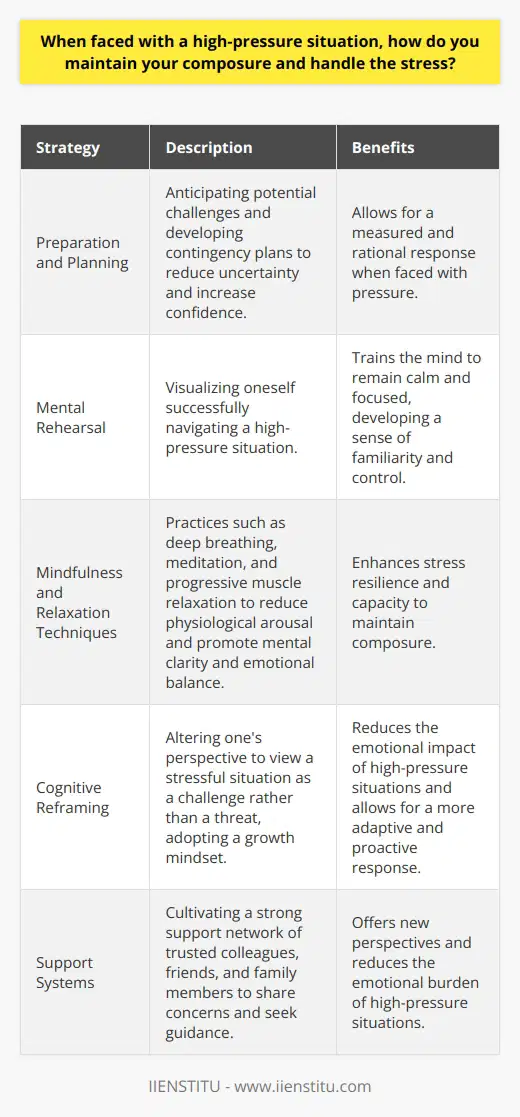
How have you managed a stressed team in the past, and can you provide specific examples?
Managing a stressed team requires a combination of effective communication, empathy, and problem-solving skills. In my previous experience as a team leader, I encountered a situation where my team was under immense pressure due to tight deadlines and a heavy workload. To address this challenge, I implemented several strategies to support and motivate the team.
Identifying the Root Causes of Stress
The first step in managing a stressed team is to identify the underlying factors contributing to their stress. In this particular case, I conducted one-on-one meetings with each team member to gain insights into their specific concerns and challenges. Through these conversations, I discovered that the team was struggling with unclear priorities and a lack of resources.
Clarifying Priorities and Expectations
To alleviate the team's stress, I worked with them to clarify priorities and set realistic expectations. We reviewed the project timeline and identified the most critical tasks that needed to be completed first. By breaking down the workload into manageable chunks and providing clear guidance on what needed to be done, the team felt more focused and less overwhelmed.
Providing Necessary Resources and Support
Additionally, I addressed the team's concerns regarding the lack of resources. I collaborated with other departments to secure the necessary tools and support that the team required to complete their tasks efficiently. This included obtaining additional software licenses, arranging training sessions, and bringing in temporary staff to assist with the workload.
Promoting Open Communication and Collaboration
Another crucial aspect of managing a stressed team is fostering open communication and collaboration. I encouraged the team to share their ideas, concerns, and suggestions regularly. We held daily stand-up meetings where each team member could provide updates on their progress, discuss any obstacles they were facing, and ask for help when needed.
Encouraging Peer Support and Knowledge Sharing
To further promote collaboration, I encouraged the team to support one another and share their knowledge and expertise. We created a shared knowledge base where team members could document their solutions to common problems, making it easier for others to find answers quickly. This collaborative approach helped to reduce stress by ensuring that team members had access to the information and support they needed.
Recognizing and Rewarding Efforts
Finally, I made it a priority to recognize and reward the team's efforts during this challenging period. I regularly acknowledged their hard work and dedication during team meetings and through individual feedback sessions. We celebrated milestones and successes along the way, even if they were small victories.
Providing Opportunities for Growth and Development
In addition to recognition, I also provided opportunities for the team to grow and develop their skills. I arranged for training sessions and workshops that aligned with their interests and career goals. By investing in their professional development, I demonstrated my commitment to their long-term success and helped to reduce stress by providing them with a sense of purpose and growth.
By implementing these strategies, I was able to effectively manage the stressed team and help them navigate through the challenging period. The team became more resilient, collaborative, and motivated, ultimately leading to the successful completion of the project. This experience taught me the importance of proactive communication, empathy, and adaptability when managing a team under pressure.
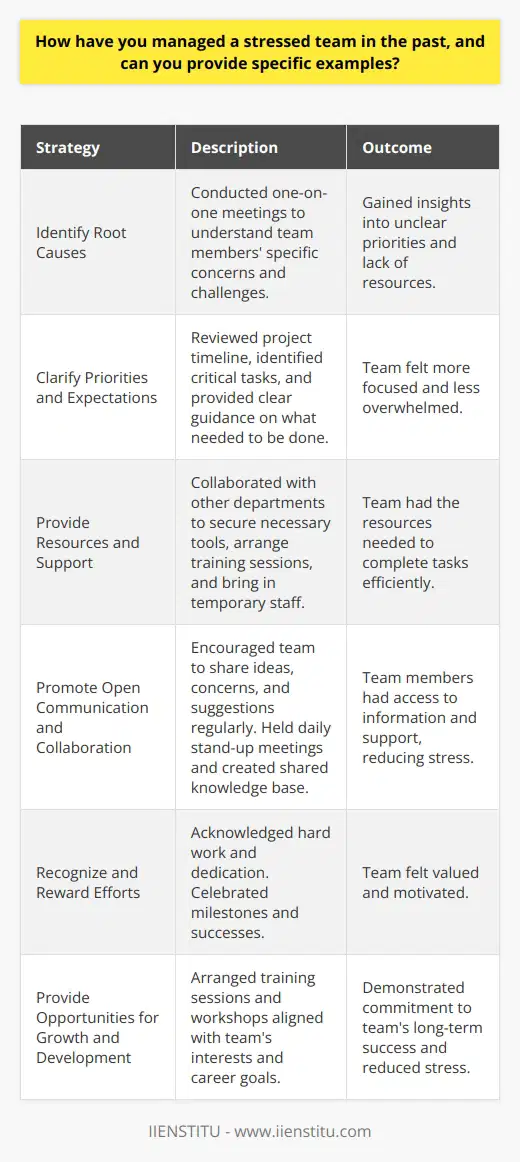
What strategies have you employed to alleviate stress within your team, and how effective were they?
Stress management is a crucial aspect of leading a team, as it directly impacts productivity, morale, and overall well-being. Over the years, I have implemented several strategies to help alleviate stress within my team, with varying degrees of success.
Open Communication and Regular Check-Ins
One of the most effective strategies I have employed is fostering open communication and conducting regular check-ins with team members. By creating a safe and supportive environment where individuals feel comfortable sharing their concerns and challenges, I have been able to identify and address potential stressors early on. This approach has proven to be highly effective in preventing stress from escalating and negatively impacting the team's performance.
Encouraging Work-Life Balance
Another key strategy I have implemented is promoting a healthy work-life balance among team members. This includes encouraging individuals to take regular breaks, disconnect from work outside of office hours, and prioritize self-care activities. By modeling these behaviors myself and providing resources and support for stress management, I have observed a significant improvement in the overall well-being and resilience of my team.
Collaborative Problem-Solving
When faced with challenging situations or high-pressure projects, I have found that engaging the team in collaborative problem-solving sessions can be highly effective in reducing stress. By bringing together diverse perspectives and expertise, we have been able to develop creative solutions and distribute workload more evenly, thereby minimizing individual stress levels. This approach has also fostered a greater sense of teamwork and shared ownership, further contributing to a positive and supportive work environment.
Recognizing and Celebrating Achievements
Regularly recognizing and celebrating the team's achievements, both big and small, has been another effective strategy for alleviating stress. By acknowledging the hard work and dedication of team members and highlighting their successes, I have been able to boost morale, increase motivation, and create a sense of pride and accomplishment within the team. This positive reinforcement has proven to be a powerful antidote to stress, helping individuals maintain a healthy perspective and stay focused on their goals.
Providing Resources and Training
Finally, I have found that investing in resources and training for stress management and resilience-building can yield significant long-term benefits. By providing access to workshops, seminars, and other learning opportunities, I have equipped my team with the tools and strategies they need to effectively cope with stress and maintain optimal performance. This proactive approach has not only helped alleviate stress in the short term but has also contributed to the overall growth and development of my team members.
In conclusion, alleviating stress within a team requires a multi-faceted approach that addresses both the immediate needs of individuals and the broader organizational culture. By fostering open communication, promoting work-life balance, engaging in collaborative problem-solving, recognizing achievements, and providing resources and training, I have been able to effectively manage stress within my team and create a positive, supportive, and high-performing work environment.

In your experience, what are the key factors that contribute to team stress, and how do you proactively address them?
In my experience, several key factors contribute to team stress, and it is crucial to address them proactively. One of the primary sources of stress is a lack of clear communication and expectations within the team. When team members are uncertain about their roles, responsibilities, and objectives, it can lead to confusion, frustration, and increased stress levels. To mitigate this, it is essential to establish clear lines of communication, regularly discuss goals and expectations, and ensure that everyone is on the same page.
Workload and Time Management
Another significant factor that contributes to team stress is an unbalanced workload and poor time management. When team members feel overwhelmed by their tasks or struggle to meet deadlines, it can create a stressful work environment. To address this, it is important to prioritize tasks, delegate responsibilities effectively, and ensure that team members have the necessary resources and support to complete their work efficiently.
Fostering a Supportive Team Environment
Fostering a supportive and collaborative team environment is crucial in reducing stress levels. When team members feel valued, respected, and supported by their colleagues, they are more likely to handle stress effectively. Encouraging open communication, promoting a positive team culture, and providing opportunities for team building and bonding can go a long way in creating a supportive work environment.
Addressing Conflicts and Interpersonal Issues
Conflicts and interpersonal issues within the team can also contribute to stress. Unresolved conflicts can lead to tension, resentment, and a breakdown in team dynamics. To proactively address this, it is essential to encourage open and respectful communication, actively listen to team members' concerns, and facilitate constructive conflict resolution. By addressing conflicts early on and promoting a culture of understanding and empathy, teams can minimize stress arising from interpersonal issues.
Promoting Work-Life Balance and Self-Care
Finally, promoting work-life balance and self-care is crucial in managing team stress. When team members feel overwhelmed and burnt out, it can have a negative impact on their well-being and productivity. Encouraging team members to prioritize their physical and mental health, take regular breaks, and maintain a healthy work-life balance can help reduce stress levels. Leaders should also lead by example and promote a culture that values self-care and well-being.
In conclusion, addressing team stress requires a proactive and multi-faceted approach. By focusing on clear communication, effective workload management, fostering a supportive team environment, addressing conflicts, and promoting work-life balance, teams can minimize stress and create a more positive and productive work environment. As a leader, it is essential to recognize the signs of stress within the team and take proactive steps to address them, ultimately promoting the well-being and success of the team as a whole.
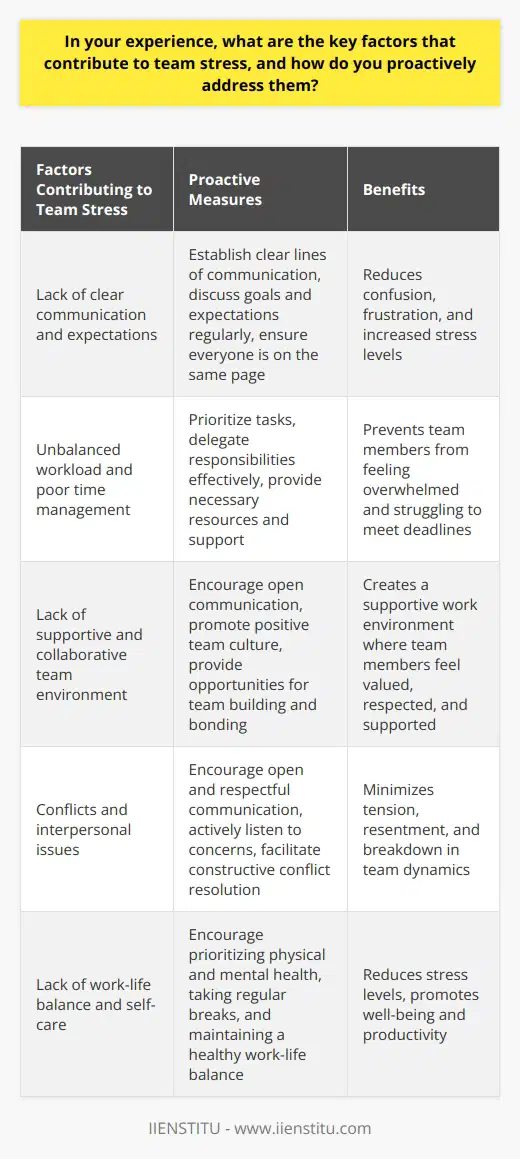
How have you successfully managed a stressed team in the past?
Managing a stressed team requires a combination of effective communication, empathy, and strategic problem-solving. In the past, I have successfully navigated such situations by first acknowledging the challenges faced by the team and validating their concerns. This approach helps to create a supportive environment where team members feel heard and understood.
Identifying the Sources of Stress
The next step involves identifying the root causes of stress within the team. This may include factors such as tight deadlines, resource constraints, or interpersonal conflicts. By conducting one-on-one conversations and team meetings, I gather insights into the specific stressors affecting each team member. This information is crucial in developing targeted strategies to alleviate the pressure.
Prioritizing and Delegating Tasks
Once the sources of stress are identified, I work with the team to prioritize tasks and responsibilities. We review the project timeline, identify critical milestones, and break down larger tasks into smaller, manageable components. By creating a clear roadmap and setting realistic expectations, team members gain a sense of control and direction.
Effective delegation is another key aspect of managing a stressed team. I assess the strengths and capabilities of each team member and assign tasks accordingly. This approach ensures that workload is distributed fairly and that individuals are given opportunities to excel in areas where they are most competent. Regular check-ins and progress updates help maintain accountability and identify any potential roadblocks.
Encouraging Open Communication and Collaboration
Fostering open communication is essential in managing a stressed team. I encourage team members to share their concerns, ideas, and feedback regularly. By creating a safe space for dialogue, individuals feel more comfortable expressing their thoughts and seeking support when needed. Regular team meetings and brainstorming sessions promote collaboration and problem-solving, allowing the team to tackle challenges together.
Providing Support and Resources
As a manager, it is crucial to provide the necessary support and resources to help the team cope with stress. This may include offering training and development opportunities to enhance skills and confidence. I also promote work-life balance by encouraging breaks, flexible working arrangements, and mental health support when needed. Recognizing and celebrating the team's achievements, no matter how small, helps boost morale and motivation.
Leading by Example
Finally, I believe in leading by example when managing a stressed team. I maintain a calm and composed demeanor, even in high-pressure situations. By demonstrating resilience and a positive attitude, I inspire the team to adopt a similar mindset. I also prioritize self-care and encourage team members to do the same, emphasizing the importance of physical and mental well-being.
Conclusion
Managing a stressed team requires a proactive and empathetic approach. By identifying the sources of stress, prioritizing tasks, fostering open communication, providing support, and leading by example, I have successfully navigated challenging situations in the past. By creating a supportive and collaborative environment, teams can overcome stress, enhance productivity, and achieve their goals.
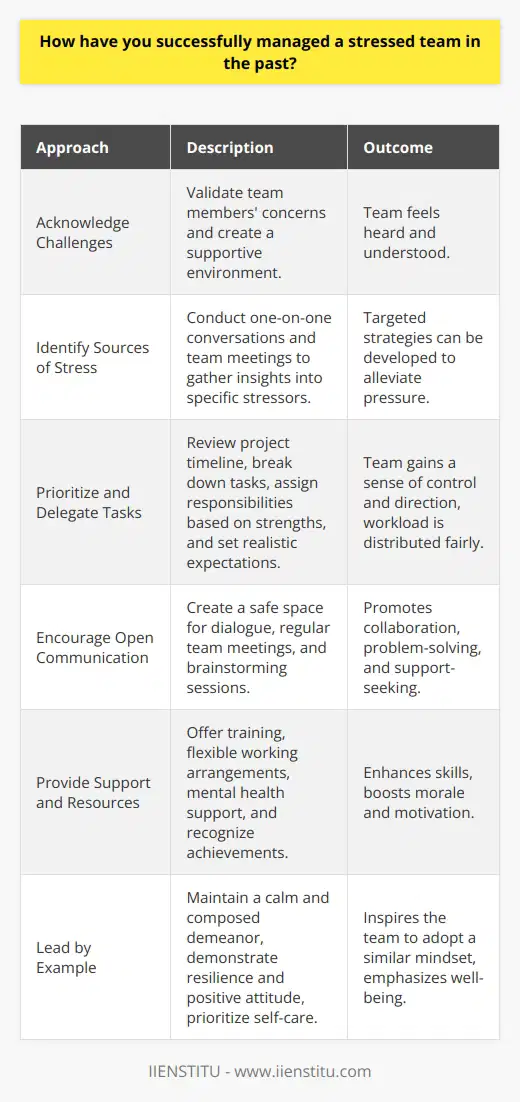
What strategies do you employ to alleviate stress and maintain team morale during challenging times?
In challenging times, it is crucial to employ effective strategies to alleviate stress and maintain team morale. One key approach is to foster open communication within the team, encouraging members to express their concerns and share their experiences. This creates a supportive environment where individuals feel heard and valued, thereby reducing stress levels and promoting a sense of unity.
Another important strategy is to prioritize self-care and promote work-life balance among team members. Encouraging regular breaks, physical activity, and mindfulness practices can help alleviate stress and improve overall well-being. By leading by example and emphasizing the importance of self-care, team leaders can create a culture that values the health and well-being of its members.
Fostering a Positive Work Environment
Creating a positive work environment is essential for maintaining team morale during difficult times. This can be achieved by recognizing and celebrating the accomplishments of team members, no matter how small. Regularly acknowledging the hard work and dedication of the team helps to boost morale and foster a sense of appreciation.
Additionally, promoting a culture of collaboration and teamwork can help alleviate stress and improve morale. Encouraging team members to support one another, share knowledge, and work together towards common goals creates a sense of camaraderie and shared purpose. This can be particularly valuable during challenging times when individuals may feel overwhelmed or isolated.
Providing Resources and Support
Offering resources and support to team members is crucial for managing stress and maintaining morale. This can include access to mental health resources, such as counseling services or employee assistance programs. By providing these resources, organizations demonstrate their commitment to the well-being of their employees and create a supportive environment.
Furthermore, providing opportunities for professional development and skill-building can help team members feel valued and invested in their work. Offering training, workshops, or mentorship programs can not only enhance the team's capabilities but also boost morale by demonstrating a commitment to their growth and development.
Promoting Flexibility and Adaptability
In challenging times, it is important to promote flexibility and adaptability within the team. This may involve adjusting work schedules, redistributing tasks, or exploring alternative ways of working to accommodate the changing needs of team members. By being open to change and willing to adapt, teams can better navigate the challenges they face and maintain a sense of resilience.
Leading with Empathy and Transparency
Effective leadership plays a vital role in alleviating stress and maintaining team morale. Leaders who demonstrate empathy, actively listen to their team members, and communicate transparently can foster a sense of trust and support within the team. By being approachable and understanding, leaders can create an environment where team members feel comfortable seeking guidance and support when needed.
Moreover, leaders who are transparent about the challenges faced by the organization and the steps being taken to address them can help alleviate uncertainty and anxiety among team members. By keeping the team informed and involved in decision-making processes, leaders can promote a sense of ownership and engagement, even during difficult times.
In conclusion, alleviating stress and maintaining team morale during challenging times requires a multifaceted approach. By fostering open communication, promoting self-care and work-life balance, creating a positive work environment, providing resources and support, promoting flexibility and adaptability, and leading with empathy and transparency, organizations can effectively support their teams through difficult periods. By prioritizing the well-being and morale of team members, organizations can build resilience and emerge stronger from challenging times.
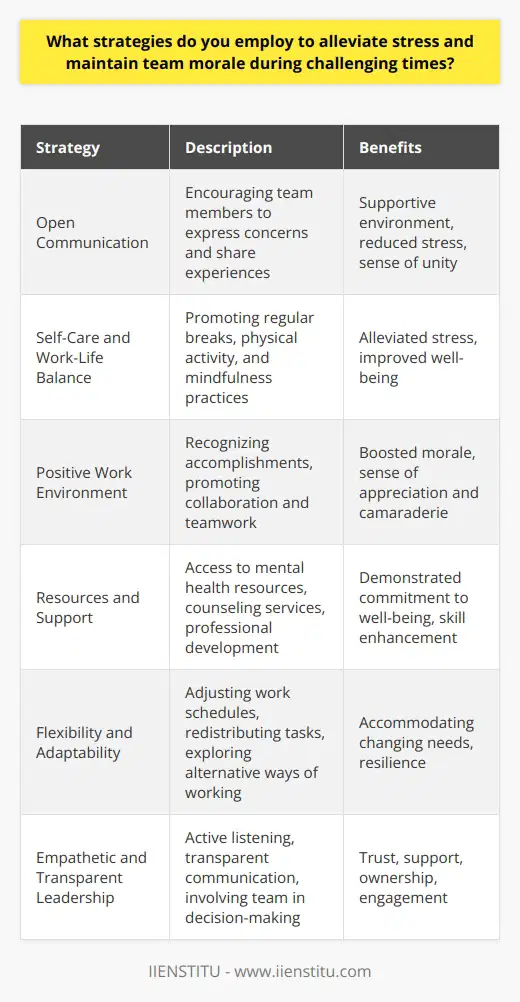
Can you describe a specific instance where you helped a stressed team overcome obstacles and achieve their goals?
In my experience as a team leader, I have encountered numerous instances where my team faced significant obstacles and stress. One specific example that stands out occurred during a critical project deadline. The team was struggling to complete the project on time due to a lack of resources and unexpected technical difficulties.
Identifying the Problem
To address the situation, I first gathered the team to identify the root causes of the issues. Through open communication and active listening, we pinpointed the specific obstacles hindering our progress. The team members expressed their concerns and frustrations, and together we brainstormed potential solutions.
Developing a Plan of Action
Once we had a clear understanding of the problems, I worked with the team to develop a plan of action. We prioritized tasks, reallocated resources, and established clear roles and responsibilities. I also reached out to other departments and stakeholders to secure additional support and resources.
Providing Support and Motivation
Throughout the process, I made sure to provide ongoing support and motivation to the team. I regularly checked in with each team member, offering guidance and encouragement. I acknowledged their hard work and celebrated small victories along the way. By maintaining a positive and supportive environment, I helped boost morale and keep the team focused on the goal.
Encouraging Collaboration and Problem-Solving
To overcome the technical difficulties, I encouraged collaboration and problem-solving within the team. We held brainstorming sessions where everyone contributed ideas and solutions. I facilitated open discussions and encouraged team members to share their expertise. By leveraging the collective knowledge and skills of the team, we were able to find creative solutions to the challenges we faced.
Leading by Example
As a leader, I understood the importance of leading by example. I actively participated in the project, taking on tasks and responsibilities alongside my team. I demonstrated a strong work ethic and a commitment to quality. By showing that I was willing to roll up my sleeves and work hard, I inspired the team to do the same.
Outcome and Lessons Learned
Through our collaborative efforts, effective communication, and unwavering determination, we successfully overcame the obstacles and delivered the project on time. The team emerged stronger, more resilient, and with a greater sense of camaraderie. From this experience, I learned the importance of proactive problem-solving, adaptability, and the power of a supportive and motivated team.
In conclusion, helping a stressed team overcome obstacles requires a combination of effective leadership, clear communication, and a focus on problem-solving. By identifying the issues, developing a plan of action, providing support and motivation, encouraging collaboration, and leading by example, leaders can guide their teams through challenging times and achieve their goals.
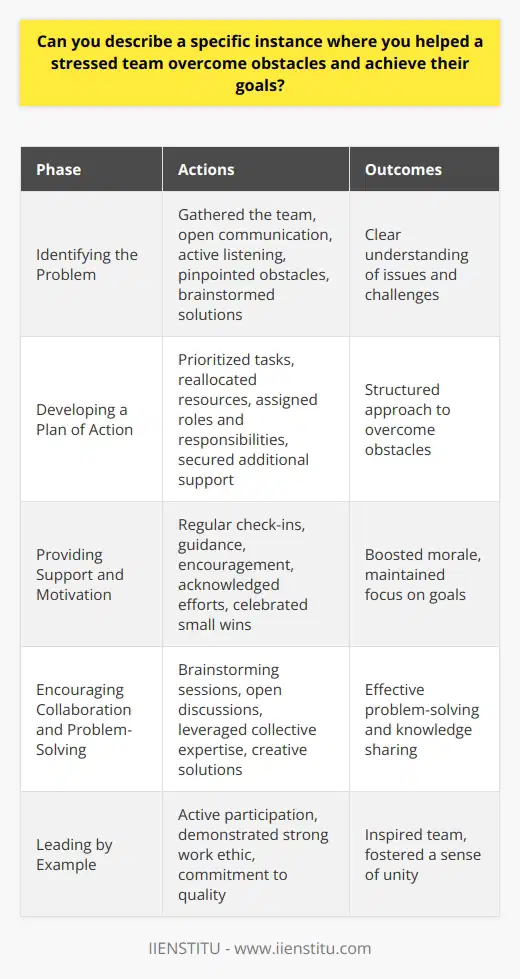
What are some common sample stress interview questions?
Stress interviews are a type of job interview designed to assess a candidate's ability to handle pressure and think on their feet. These interviews often involve challenging questions, hypothetical scenarios, and sometimes even confrontational or aggressive behavior from the interviewer. The goal is to see how the candidate reacts under stress and whether they can maintain their composure and professionalism.
Common Sample Stress Interview Questions
1. Handling Conflict
Interviewers may ask questions about how you handle conflict or difficult situations in the workplace. They want to know if you can remain calm and professional when faced with challenges. An example question might be, "Tell me about a time when you had to deal with a difficult colleague or customer. How did you handle the situation?"
2. Problem-Solving
Stress interviews often involve questions that test your problem-solving skills under pressure. The interviewer may present you with a hypothetical scenario and ask you to come up with a solution on the spot. For example, "Imagine you're working on a project with a tight deadline, and a key team member suddenly quits. What would you do?"
3. Adaptability
Interviewers may also ask questions that assess your ability to adapt to change and handle unexpected situations. They want to see if you can think on your feet and come up with creative solutions. An example question might be, "How would you react if your manager suddenly changed the direction of a project you've been working on for weeks?"
4. Ethical Dilemmas
Some stress interview questions may involve ethical dilemmas or moral quandaries. The interviewer wants to see how you navigate complex situations and make difficult decisions. For example, "Imagine you discover that a colleague has been falsifying expense reports. What would you do?"
5. Personal Weaknesses
Interviewers may also ask questions that probe your self-awareness and ability to acknowledge your own weaknesses. They want to see if you can be honest and reflective about areas where you need improvement. An example question might be, "What is your biggest weakness, and how are you working to overcome it?"
Tips for Handling Stress Interview Questions
1. Stay Calm
The most important thing to remember during a stress interview is to stay calm and composed. Take deep breaths, maintain eye contact, and try to keep your body language relaxed and confident.
2. Think Before You Speak
When faced with a challenging question, take a moment to collect your thoughts before responding. It's better to pause and give a thoughtful answer than to blurt out something you might regret later.
3. Be Honest
Don't try to bluff your way through a question or give an answer you think the interviewer wants to hear. Be honest about your experiences, strengths, and weaknesses.
4. Focus on Solutions
When presented with a problem or scenario, focus on finding solutions rather than dwelling on the negative aspects of the situation. Show that you can think critically and come up with creative ideas under pressure.
Conclusion
While stress interviews can be intimidating, they are an opportunity to showcase your ability to handle pressure and think on your feet. By preparing for common stress interview questions and practicing your responses, you can demonstrate your professionalism and resilience to potential employers. Remember to stay calm, be honest, and focus on solutions, and you'll be well-equipped to handle even the toughest stress interview questions.
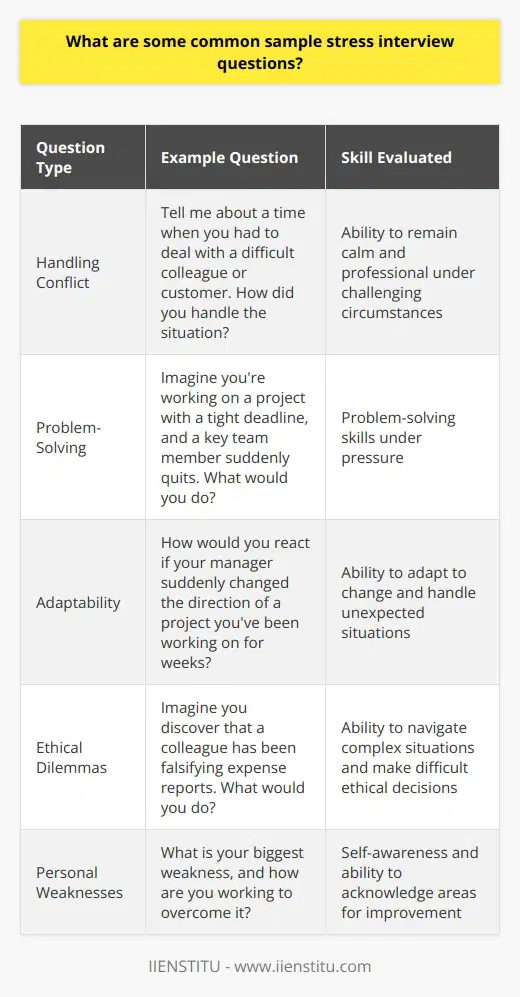
How should I answer sample stress interview questions?
Answering sample stress interview questions requires a strategic approach to showcase your ability to handle pressure and think critically. When faced with these types of questions, it's essential to remain calm, composed, and focused on providing thoughtful responses. Take a moment to collect your thoughts before answering, and consider using the STAR method (Situation, Task, Action, Result) to structure your reply. This technique allows you to provide a specific example of how you successfully handled a stressful situation in the past, demonstrating your problem-solving skills and resilience. Additionally, be honest about your experiences and avoid exaggerating or downplaying the challenges you faced. Authenticity is key in building trust with the interviewer and highlighting your genuine ability to navigate difficult circumstances.
Preparing for Stress Interview Questions
To effectively prepare for stress interview questions, it's crucial to anticipate the types of questions you may encounter. Research common stress interview questions and practice your responses beforehand. This preparation will help you feel more confident and less caught off guard during the actual interview. Consider asking a friend or family member to conduct a mock interview, allowing you to practice your answers in a simulated environment. Pay attention to your body language and tone of voice, as these nonverbal cues can significantly impact how your responses are perceived. Maintain good eye contact, sit up straight, and speak clearly and concisely. Remember, the interviewer is not only evaluating your verbal responses but also assessing how you handle the pressure of the situation.
Highlighting Your Stress Management Techniques
When answering stress interview questions, it's important to highlight the specific stress management techniques you employ. Discuss how you prioritize tasks, break down complex projects into manageable steps, and maintain a positive attitude in the face of challenges. Share examples of how you've successfully delegated responsibilities, communicated effectively with team members, and sought guidance when needed. Emphasize your ability to remain organized and focused, even under tight deadlines or in high-pressure situations. By showcasing your proactive approach to stress management, you demonstrate your resilience and adaptability, qualities that are highly valued in any professional setting.
Demonstrating Emotional Intelligence
In addition to highlighting your technical skills and problem-solving abilities, it's crucial to demonstrate your emotional intelligence when answering stress interview questions. Discuss how you manage your own emotions and remain level-headed in challenging situations. Share examples of how you've empathized with colleagues or clients, fostering a positive and collaborative work environment. Highlight your ability to actively listen, communicate effectively, and maintain a professional demeanor, even in the face of adversity. By showcasing your emotional intelligence, you demonstrate your ability to navigate complex interpersonal dynamics and contribute to a healthy and productive workplace.
Embracing the Opportunity for Growth
Finally, when answering stress interview questions, it's important to frame challenges as opportunities for growth and learning. Discuss how you've used stressful experiences to develop new skills, gain valuable insights, and become a more resilient and adaptable professional. Share examples of how you've learned from past mistakes, sought feedback from colleagues and mentors, and continuously worked to improve your performance. By embracing a growth mindset and demonstrating a willingness to learn and evolve, you showcase your potential as a valuable asset to any organization.
Remember, the key to successfully answering stress interview questions is to remain calm, authentic, and focused on highlighting your strengths and experiences. By preparing in advance, utilizing effective stress management techniques, demonstrating emotional intelligence, and embracing challenges as opportunities for growth, you can confidently navigate even the most challenging interview questions and leave a lasting positive impression on potential employers.
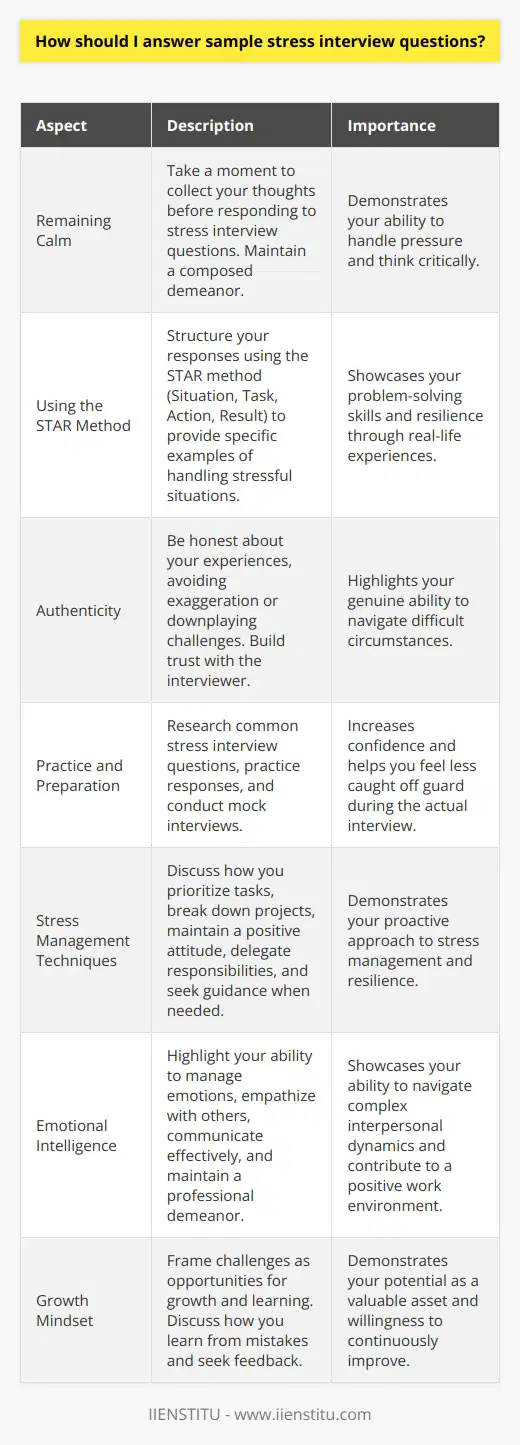
What are effective strategies for responding to sample stress interview questions?
Responding to sample stress interview questions requires a combination of preparation, self-awareness, and effective communication strategies. To successfully navigate these challenging inquiries, job seekers should focus on showcasing their problem-solving abilities, adaptability, and resilience. By anticipating potential stress-inducing questions and practicing thoughtful responses, candidates can demonstrate their capacity to handle pressure and maintain composure in demanding situations.
Prepare for Common Stress Interview Questions
Familiarize yourself with typical stress interview questions, such as "How do you handle conflict with a colleague?" or "Describe a time when you failed and how you responded." Reflect on your past experiences and identify specific instances that highlight your ability to overcome adversity, learn from mistakes, and maintain a positive attitude in the face of challenges. Develop concise, honest, and compelling narratives that illustrate your growth and resilience.
Practice Self-Reflection and Emotional Regulation
Engage in self-reflection to gain a deeper understanding of your emotional triggers and stress response patterns. Recognize the physical and mental signs of stress, such as increased heart rate or negative self-talk. Practice stress management techniques, like deep breathing or mindfulness exercises, to regulate your emotions and maintain a calm demeanor during the interview. By demonstrating self-awareness and emotional control, you convey your ability to handle high-pressure situations effectively.
Focus on Problem-Solving and Adaptability
When responding to stress interview questions, emphasize your problem-solving skills and adaptability. Share examples of how you have successfully navigated complex challenges, adapted to changing circumstances, and generated innovative solutions. Highlight your ability to think critically, gather relevant information, and make well-informed decisions under pressure. By showcasing your problem-solving prowess, you demonstrate your potential to be a valuable asset in a demanding work environment.
Communicate with Confidence and Clarity
Effective communication is crucial when responding to stress interview questions. Speak clearly, maintain eye contact, and use a confident tone of voice. Avoid rambling or getting defensive; instead, provide concise and well-structured responses that directly address the question. Use specific examples to illustrate your points and emphasize the lessons you learned from each experience. By communicating with confidence and clarity, you instill trust in your abilities and demonstrate your capacity to articulate your thoughts effectively under pressure.
Maintain a Positive and Professional Attitude
Throughout the stress interview, maintain a positive and professional attitude. Avoid complaining or making negative comments about past experiences or colleagues. Instead, frame challenges as opportunities for growth and learning. Demonstrate enthusiasm for the role and the company, and express your willingness to take on new challenges. By projecting a positive and professional demeanor, you show the interviewer that you can maintain composure and remain focused on achieving goals, even in high-stress situations.
Conclusion
Responding effectively to sample stress interview questions requires a proactive approach that combines preparation, self-awareness, and strong communication skills. By anticipating common questions, practicing self-reflection, focusing on problem-solving, communicating with confidence, and maintaining a positive attitude, job seekers can successfully navigate the challenges of a stress interview and demonstrate their potential to thrive in a demanding work environment.
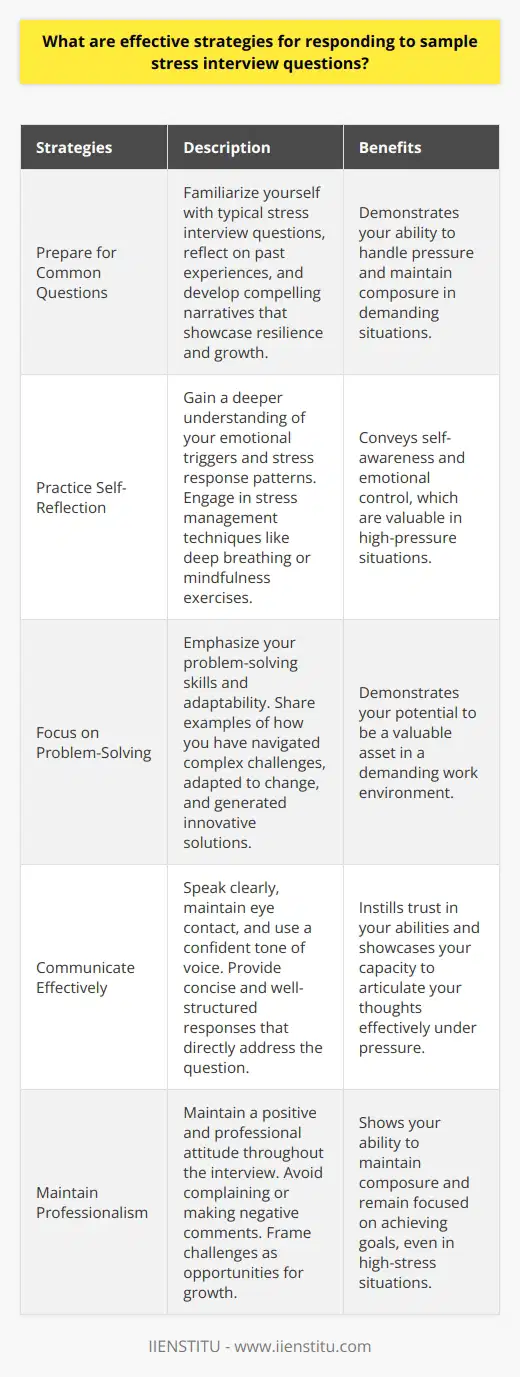
How do you handle stressful situations at work?
Handling stressful situations at work requires a multifaceted approach that involves both personal and organizational strategies. Individuals can employ various techniques to manage stress, such as practicing mindfulness, engaging in regular exercise, and maintaining a healthy work-life balance. Effective time management and prioritization of tasks can also help reduce the feeling of being overwhelmed by work demands.
Developing Resilience
Building resilience is crucial for coping with stressful situations in the workplace. Resilience enables individuals to adapt to challenges and bounce back from setbacks. To develop resilience, it is essential to cultivate a positive mindset, focus on solutions rather than problems, and learn from past experiences. Seeking support from colleagues, mentors, or employee assistance programs can also contribute to building resilience.
Effective Communication
Clear and open communication is vital for managing stress in the workplace. When faced with stressful situations, it is important to express concerns and needs assertively and professionally. Engaging in active listening and providing constructive feedback can help foster understanding and collaboration among team members. Regular check-ins with supervisors and colleagues can also help identify and address potential stressors before they escalate.
Organizational Support
Organizations play a significant role in creating a supportive environment that promotes stress management. Implementing policies that encourage work-life balance, such as flexible work arrangements or paid time off, can help reduce stress levels. Providing access to stress management resources, such as workshops, seminars, or counseling services, can equip employees with tools to handle stressful situations effectively.
Self-Care Practices
Engaging in regular self-care practices is essential for managing stress at work. Taking short breaks throughout the day to stretch, meditate, or engage in deep breathing exercises can help reduce tension and improve focus. Maintaining a healthy lifestyle, including a balanced diet, sufficient sleep, and regular exercise, can also enhance overall well-being and stress resilience.
Ultimately, handling stressful situations at work requires a proactive and holistic approach that combines individual strategies and organizational support. By developing resilience, communicating effectively, and prioritizing self-care, individuals can navigate challenging work environments with greater ease and maintain their professional performance and personal well-being.

How do you cope with stress when deadlines are approaching?
Coping with stress when deadlines approach is a common challenge for students and professionals alike. Developing effective strategies to manage stress is crucial for maintaining productivity and well-being. One key approach is to break down tasks into smaller, manageable chunks and prioritize them based on urgency and importance. This helps to create a sense of control and progress, reducing feelings of overwhelm.
Time Management Techniques
Implementing time management techniques, such as the Pomodoro Technique or time blocking, can also be beneficial. These methods involve dedicating focused periods to specific tasks, followed by short breaks to recharge. By structuring your work in this way, you can maintain concentration and avoid burnout. Additionally, creating a realistic schedule and allowing for buffer time can help alleviate pressure and accommodate unexpected challenges.
Self-Care Practices
Engaging in regular self-care practices is another essential aspect of coping with deadline-related stress. Make sure to prioritize sleep, as lack of rest can exacerbate stress and impair cognitive function. Exercise, even in short bursts, releases endorphins and reduces tension in the body. Mindfulness activities, such as deep breathing exercises or meditation, can help calm the mind and improve focus.
Support Systems
Building a strong support system is also crucial during times of stress. Reach out to friends, family, or colleagues for emotional support and practical assistance when needed. Collaborating with others can provide fresh perspectives and help distribute the workload. Remember that seeking help is a sign of strength, not weakness.
Positive Self-Talk
Cultivating a positive mindset through self-talk can significantly impact how you cope with stress. Challenge negative thoughts and replace them with constructive, encouraging statements. Acknowledge your past successes and remind yourself of your capabilities. Celebrate small victories along the way to maintain motivation and a sense of accomplishment.
Balanced Lifestyle
Maintaining a balanced lifestyle, even during busy periods, is essential for long-term stress management. Make time for hobbies and activities that bring you joy and relaxation. Engage in creative pursuits, spend time in nature, or connect with loved ones. These activities provide a necessary break from work and help replenish your energy and resilience.
By implementing a combination of these strategies, you can effectively cope with stress when deadlines loom. Remember to be kind to yourself, practice self-compassion, and maintain perspective. Deadlines are temporary, and with the right approach, you can navigate them successfully while preserving your well-being.

What strategies do you use to manage stress in high-pressure environments?
Managing stress in high-pressure environments requires a multifaceted approach that includes both personal and professional strategies. One effective method is to prioritize tasks and create a clear plan of action. This helps to break down complex projects into manageable steps, reducing feelings of overwhelm. Additionally, setting realistic goals and deadlines can prevent the accumulation of stress over time.
Effective Communication and Delegation
Effective communication is crucial in high-pressure environments. Clearly expressing concerns, expectations, and progress updates can help team members stay on the same page. Moreover, delegating tasks to qualified individuals can alleviate personal workload and foster a sense of trust within the team. It is essential to recognize the strengths of team members and assign responsibilities accordingly.
Self-Care Practices
Incorporating self-care practices into daily routines can significantly reduce stress levels. Engaging in regular physical exercise, such as yoga or jogging, can help release endorphins and improve overall well-being. Practicing mindfulness techniques, like deep breathing or meditation, can also promote relaxation and mental clarity. Furthermore, maintaining a balanced diet and getting sufficient sleep are crucial for managing stress in high-pressure environments.
Establishing Boundaries and Seeking Support
Setting clear boundaries between work and personal life is essential for managing stress. This may involve establishing specific work hours, minimizing work-related activities outside of designated times, and learning to say no when necessary. Additionally, seeking support from colleagues, mentors, or professional counselors can provide valuable perspectives and coping strategies. Building a strong support network can help individuals navigate challenging situations and maintain emotional well-being.
Continuous Learning and Adaptability
Embracing continuous learning and adaptability can help individuals thrive in high-pressure environments. Staying updated with industry trends, acquiring new skills, and being open to feedback can enhance confidence and resilience. Moreover, cultivating a growth mindset, which views challenges as opportunities for learning and development, can reframe stressful situations in a more positive light. By consistently expanding one's knowledge and skill set, individuals can better navigate the demands of high-pressure environments.
In conclusion, managing stress in high-pressure environments requires a proactive and holistic approach. By prioritizing tasks, communicating effectively, engaging in self-care practices, setting boundaries, seeking support, and embracing continuous learning, individuals can develop the resilience and coping mechanisms necessary to thrive in challenging situations. Ultimately, the key to success lies in finding a balance between personal well-being and professional performance.
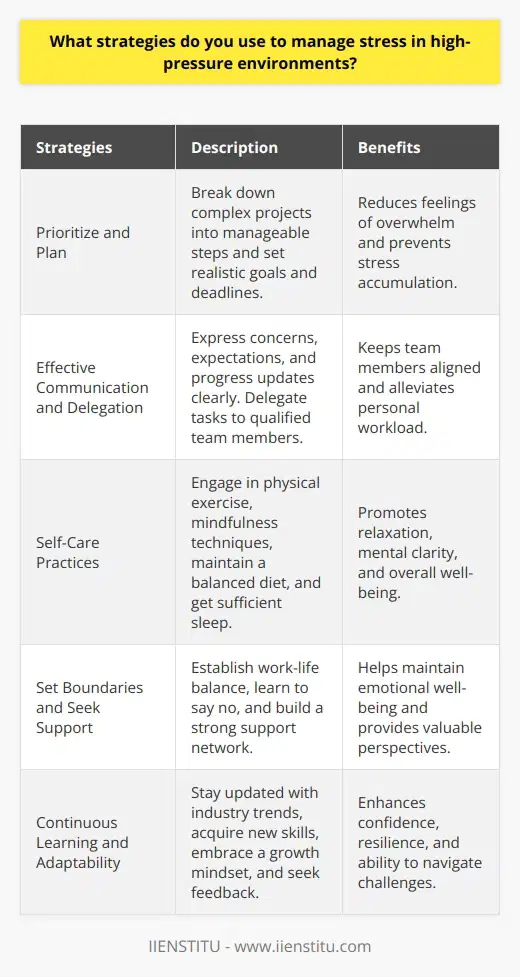
How do you manage stress and pressure in your professional life?
Managing stress and pressure in professional life is crucial for maintaining well-being and achieving long-term success. Effective stress management involves a combination of strategies that address both the physical and psychological aspects of stress. By implementing these strategies consistently, individuals can reduce the negative impact of stress on their health, productivity, and overall quality of life.
Prioritizing Self-Care
One of the most important aspects of managing stress in professional life is prioritizing self-care. This includes engaging in regular physical exercise, maintaining a balanced diet, and ensuring adequate sleep. Exercise helps to reduce stress by releasing endorphins, improving mood, and boosting energy levels. Eating a nutritious diet provides the body with the necessary nutrients to cope with stress, while sufficient sleep allows the mind and body to recharge and recover.
Mindfulness and Relaxation Techniques
Incorporating mindfulness and relaxation techniques into daily routines can significantly reduce stress levels. Practices such as meditation, deep breathing exercises, and yoga help to calm the mind, reduce anxiety, and promote a sense of inner peace. These techniques can be easily integrated into busy schedules, even if only for a few minutes each day. Regular practice of mindfulness and relaxation can improve focus, clarity, and emotional resilience in the face of stressful situations.
Time Management and Boundary Setting
Effective time management is essential for reducing stress in professional life. This involves prioritizing tasks, setting realistic goals, and allocating sufficient time for each activity. By breaking down large projects into smaller, manageable steps, individuals can avoid feeling overwhelmed and maintain a sense of control over their workload. Additionally, learning to set clear boundaries between work and personal life is crucial for preventing work-related stress from spilling over into other areas of life.
Building a Support Network
Developing a strong support network of colleagues, friends, and family members can provide valuable emotional support during times of stress. Engaging in open communication with trusted individuals allows for the sharing of concerns, challenges, and successes. This sense of connection and support can help to alleviate feelings of isolation and provide a fresh perspective on stressful situations. Seeking guidance from mentors or professional counselors can also offer valuable insights and strategies for managing stress.
Cultivating Resilience and Adaptability
Building resilience and adaptability is key to effectively managing stress in the long term. This involves developing a growth mindset, embracing challenges as opportunities for learning and growth, and maintaining a positive outlook in the face of adversity. By focusing on solutions rather than dwelling on problems, individuals can foster a sense of empowerment and control over their circumstances. Regularly engaging in activities that promote personal growth, such as learning new skills or pursuing hobbies, can also contribute to increased resilience and adaptability.
In conclusion, managing stress and pressure in professional life requires a proactive and holistic approach. By prioritizing self-care, incorporating mindfulness and relaxation techniques, practicing effective time management, building a support network, and cultivating resilience and adaptability, individuals can successfully navigate the challenges of their professional lives while maintaining their well-being and achieving their goals.
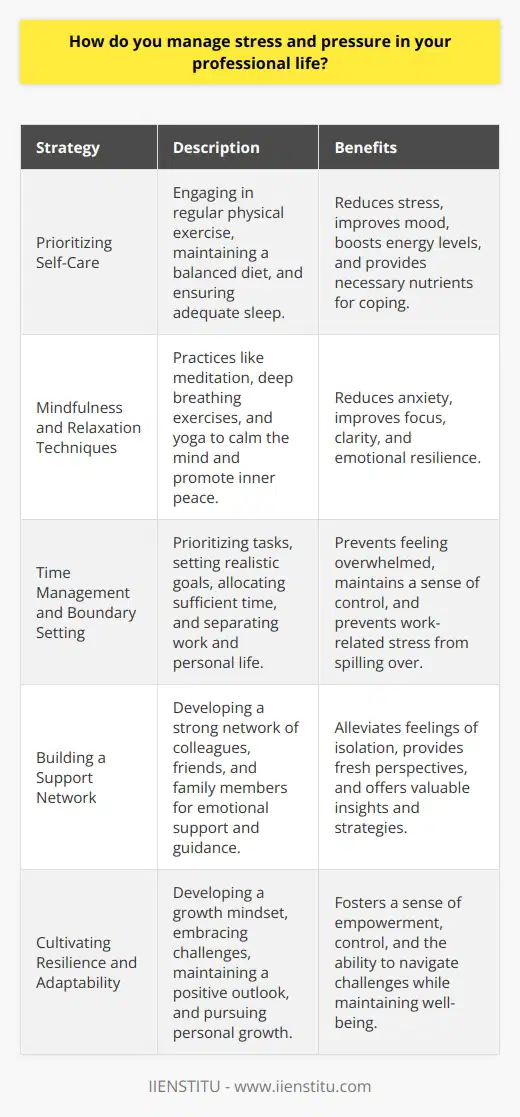
What strategies do you employ to cope with stressful situations at work?
Coping with stressful situations at work is crucial for maintaining productivity and well-being. Several strategies can be employed to effectively manage stress in the workplace.
Prioritizing and Time Management
One of the most effective ways to cope with stress is to prioritize tasks and manage time efficiently. Create a to-do list and tackle the most important and time-sensitive tasks first. Break large projects into smaller, manageable steps to avoid feeling overwhelmed. Use time-blocking techniques to allocate specific time slots for different tasks, ensuring a balanced workload.
Effective Communication
Open and clear communication with colleagues and supervisors can help alleviate stress. When faced with a challenging situation, discuss your concerns and seek guidance or support. Collaborate with team members to find solutions and distribute tasks evenly. Maintain a professional and respectful tone in all work-related interactions to foster a positive work environment.
Delegation and Boundaries
Learn to delegate tasks when appropriate and set clear boundaries to avoid taking on excessive responsibilities. Recognize your limits and communicate them assertively to prevent burnout. Saying "no" to non-essential tasks or requests can help you focus on your core responsibilities and maintain a manageable workload.
Self-Care and Stress-Relief Techniques
Engaging in regular self-care activities and stress-relief techniques is essential for coping with work-related stress. Take short breaks throughout the day to recharge and refocus. Practice deep breathing exercises or meditation to calm your mind and reduce anxiety. Engage in physical activities, such as walking or stretching, to release tension and boost endorphins.
Maintain a Healthy Work-Life Balance
Establishing a clear separation between work and personal life is crucial for managing stress. Set boundaries and avoid checking work emails or taking work-related calls outside of designated hours. Engage in hobbies and activities that bring you joy and relaxation during your free time. Prioritize quality time with family and friends to maintain a strong support system outside of work.
Seeking Professional Support
If work-related stress becomes overwhelming and affects your mental health, don't hesitate to seek professional support. Many organizations offer employee assistance programs (EAPs) that provide confidential counseling services. Talking to a therapist or counselor can help you develop personalized coping strategies and work through challenging situations.
Continuous Learning and Skill Development
Investing in continuous learning and skill development can boost confidence and reduce stress in the workplace. Attend training sessions, workshops, or conferences to enhance your knowledge and skills. Stay updated with industry trends and best practices to feel more prepared and equipped to handle work challenges.
Remember, coping with stress is an ongoing process that requires consistent effort and self-awareness. By implementing these strategies and prioritizing your well-being, you can effectively navigate stressful situations at work and maintain a healthy and productive professional life.
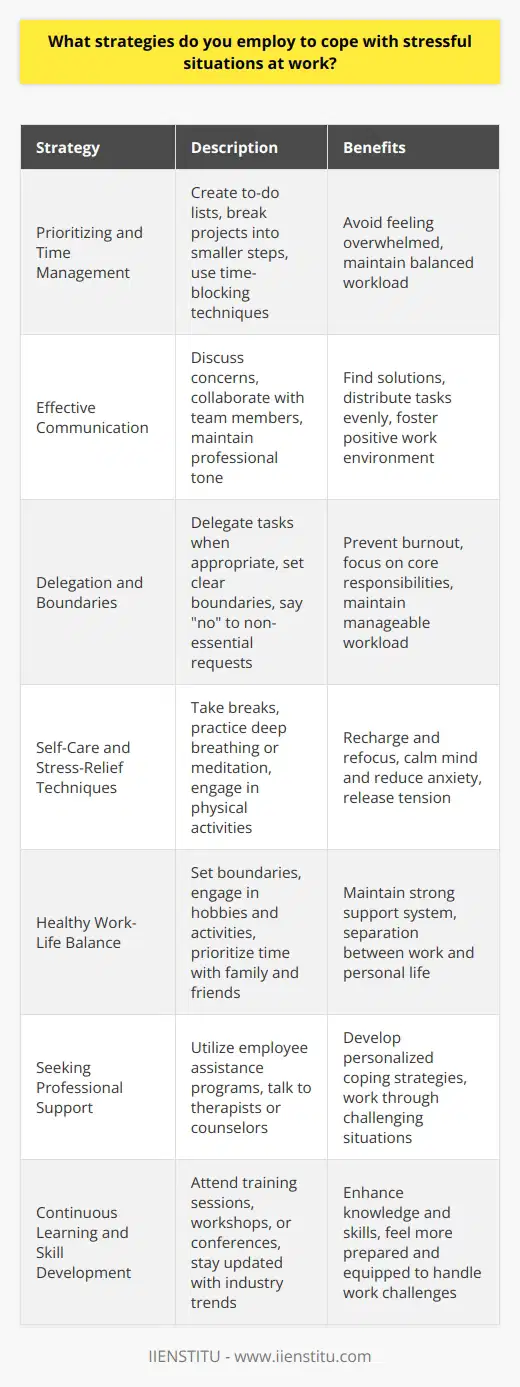
How do you maintain your composure and productivity when faced with high-pressure deadlines or challenges in your job?
Maintaining composure and productivity in high-pressure situations is crucial for success in any job. One effective strategy is to prioritize tasks based on their urgency and importance. This helps you focus on the most critical tasks first, reducing stress and increasing efficiency. Another key aspect is effective time management, which involves breaking down large projects into smaller, manageable tasks and setting realistic deadlines for each.
Develop a Positive Mindset
Cultivating a positive mindset is essential when facing challenges at work. Reframe obstacles as opportunities for growth and learning. Embrace a solution-oriented approach, focusing on finding ways to overcome hurdles rather than dwelling on the problems. Regularly practice stress-management techniques such as deep breathing, meditation, or mindfulness to maintain a calm and centered state of mind.
Communicate Effectively
Clear communication is vital when working under pressure. Keep your team and supervisors informed about your progress and any issues that arise. Don't hesitate to ask for help or clarification when needed. Collaborate with colleagues to brainstorm ideas and find creative solutions to challenges. Foster a supportive and open work environment where everyone feels comfortable sharing their thoughts and concerns.
Take Care of Your Well-being
To maintain peak performance, prioritize your physical and mental well-being. Make sure to get enough sleep, eat a balanced diet, and exercise regularly. Take short breaks throughout the day to recharge and refocus. Engage in activities that you enjoy outside of work to maintain a healthy work-life balance. Remember to set boundaries and avoid overextending yourself, as burnout can significantly impact your productivity and composure.
Learn from Experiences
Reflect on past experiences where you successfully handled high-pressure situations. Identify the strategies and techniques that worked well for you and apply them to current challenges. Continuously seek feedback from colleagues and supervisors to identify areas for improvement. Embrace a growth mindset, viewing each challenge as an opportunity to learn and develop new skills.
Stay Organized and Adaptable
Maintain a clean and organized workspace to minimize distractions and increase focus. Use tools like calendars, to-do lists, and project management software to stay on top of deadlines and responsibilities. Be prepared to adapt to changing circumstances and adjust your plans accordingly. Embrace flexibility and be open to alternative approaches when faced with unexpected obstacles.
Celebrate Successes
Take time to acknowledge and celebrate your successes, no matter how small. Recognizing your achievements can boost motivation and confidence, helping you tackle future challenges with a positive outlook. Share your successes with your team and express gratitude for their support and contributions.
Seek Support
Don't hesitate to reach out for support when needed. Talk to a trusted colleague, mentor, or supervisor about your concerns and seek their advice. Consider joining professional networks or attending workshops to connect with others in your field and learn from their experiences.
By implementing these strategies and maintaining a proactive approach, you can effectively navigate high-pressure situations and maintain your composure and productivity in the face of challenges. Remember, success is not about perfection but rather about resilience, adaptability, and a commitment to continuous growth and improvement.
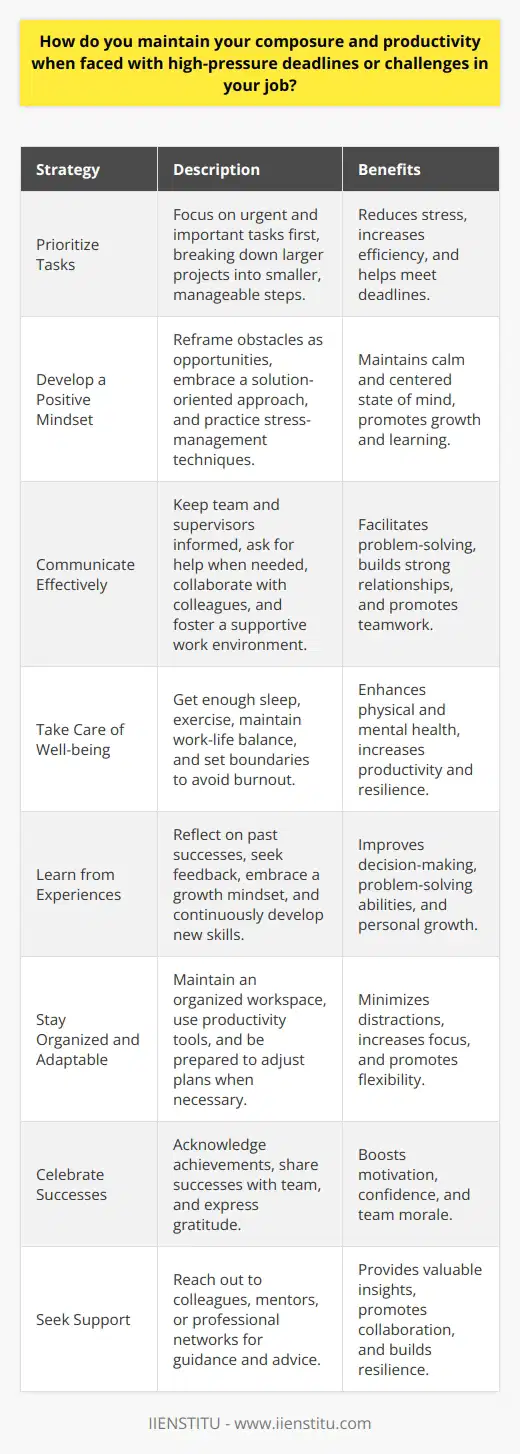
How have you successfully managed a stressed team in the past?
Managing a stressed team requires a multifaceted approach that addresses both individual and collective needs. In my experience, the first step is to identify the sources of stress within the team. This can be accomplished through open and honest communication with team members, as well as careful observation of team dynamics. Once the stressors have been identified, it is essential to develop a plan of action that addresses each issue systematically.
Fostering Open Communication
One of the most effective ways to manage a stressed team is to foster open communication. Encouraging team members to express their concerns and ideas openly can help alleviate tension and promote a sense of unity. Regular team meetings, one-on-one check-ins, and anonymous feedback mechanisms can all contribute to creating a safe space for communication. By actively listening to team members and addressing their concerns, a manager can demonstrate empathy and build trust within the team.
Prioritizing Tasks and Setting Clear Goals
When a team is stressed, it is often due to an overwhelming workload or unclear priorities. As a manager, it is crucial to help the team prioritize tasks and set clear, achievable goals. This can be done by breaking down larger projects into smaller, manageable tasks and establishing realistic deadlines. By providing a clear roadmap and regularly reviewing progress, a manager can help the team stay focused and motivated, even under pressure.
Encouraging Work-Life Balance
Stress can often be exacerbated by a lack of work-life balance. Encouraging team members to take breaks, use their vacation time, and maintain healthy boundaries between work and personal life can help reduce stress levels. As a manager, leading by example and promoting a culture that values well-being can go a long way in supporting the team's mental health.
Providing Resources and Support
When a team is under stress, it is essential to provide them with the resources and support they need to succeed. This may include additional training, access to mental health resources, or simply offering a listening ear. By demonstrating a commitment to the team's well-being and professional development, a manager can help alleviate stress and build resilience within the team.
Celebrating Successes and Learning from Failures
Finally, it is important to celebrate the team's successes and learn from their failures. Acknowledging the hard work and achievements of the team can boost morale and provide a sense of accomplishment. When setbacks occur, it is crucial to approach them as learning opportunities rather than failures. By fostering a growth mindset and emphasizing the importance of continuous improvement, a manager can help the team navigate challenges and emerge stronger.
Conclusion
Managing a stressed team requires a proactive and empathetic approach. By fostering open communication, prioritizing tasks, encouraging work-life balance, providing resources and support, and celebrating successes while learning from failures, a manager can help alleviate stress and promote a healthy, productive work environment.

What strategies do you employ to alleviate stress within your team?
Effective stress management is crucial for maintaining a productive and healthy team environment. Implementing strategies to alleviate stress within the team can lead to improved morale, increased job satisfaction, and enhanced overall performance. This paragraph will explore various approaches to mitigating stress among team members.
Encouraging Open Communication
One of the most important strategies for alleviating stress within a team is fostering open communication. Encouraging team members to express their concerns, challenges, and feelings can help identify potential stressors early on. Regular check-ins, one-on-one meetings, and team discussions provide opportunities for individuals to share their experiences and seek support.
Creating a Safe Space
Establishing a safe and non-judgmental environment is essential for promoting open communication. Team members should feel comfortable discussing their struggles without fear of criticism or repercussions. Leaders can model vulnerability by sharing their own experiences and demonstrating empathy towards others.
Promoting Work-Life Balance
Encouraging a healthy work-life balance is another key strategy for reducing stress within the team. Recognizing the importance of personal time and self-care can prevent burnout and maintain overall well-being. Flexible work arrangements, such as remote work options or adjustable schedules, can help team members manage their responsibilities outside of work.
Setting Realistic Expectations
Managers should set realistic expectations for their team to avoid overloading individuals with excessive workloads. Clearly communicating priorities, deadlines, and resources can help team members manage their tasks effectively. Regularly reviewing and adjusting workloads can prevent individuals from becoming overwhelmed and stressed.
Providing Resources and Support
Offering resources and support is crucial for helping team members cope with stress. This can include access to mental health services, wellness programs, or stress management workshops. Encouraging the use of available resources and normalizing discussions about mental well-being can create a supportive team culture.
Promoting Stress-Reducing Activities
Incorporating stress-reducing activities into the team's routine can help alleviate tension and promote relaxation. This can include team-building exercises, mindfulness practices, or physical activities like yoga or group walks. Encouraging breaks throughout the day and providing designated quiet spaces can also help team members recharge and manage stress.
Recognizing and Celebrating Achievements
Acknowledging and celebrating the team's successes and milestones can boost morale and reduce stress. Recognizing individual contributions, expressing gratitude, and providing positive feedback can help team members feel valued and appreciated. Celebrating achievements, both big and small, can foster a sense of accomplishment and unity within the team.
By implementing these strategies, leaders can create a supportive and resilient team environment that effectively manages stress. Prioritizing the well-being of team members not only improves individual performance but also contributes to the overall success and productivity of the team.

Can you provide an example of a time when you effectively led a team through a high-pressure situation?
Leading a team through a high-pressure situation requires effective communication, delegation, and problem-solving skills. One example of successfully navigating such a scenario occurred during a critical project deadline at my previous company. As the project manager, I had to ensure that our team delivered the final product to the client within a tight timeframe, despite several unexpected obstacles.
Assessing the Situation and Creating a Plan
Upon realizing the challenges we faced, I quickly gathered the team to assess the situation. We identified the key issues hindering our progress and brainstormed potential solutions. I encouraged open communication and valued each team member's input, fostering a collaborative environment. Together, we developed a comprehensive action plan that outlined clear responsibilities and deadlines for each task.
Delegating Tasks and Providing Support
I carefully assigned tasks to team members based on their strengths and expertise. I made sure everyone understood their roles and had the necessary resources to complete their work. Throughout the project, I regularly checked in with each team member, offering guidance and support as needed. By being available and approachable, I helped maintain a positive team dynamic and addressed any concerns promptly.
Monitoring Progress and Adapting to Changes
To stay on track, I implemented a daily stand-up meeting to monitor progress and identify any roadblocks. When unforeseen issues arose, I encouraged the team to think creatively and adapt our plan accordingly. By remaining flexible and open to new ideas, we were able to find effective solutions and keep the project moving forward.
Communicating with Stakeholders
Throughout the high-pressure situation, I maintained open lines of communication with both the client and upper management. I provided regular updates on our progress, any challenges we encountered, and our strategies to mitigate them. By keeping stakeholders informed and managing their expectations, I built trust and confidence in our team's ability to deliver.
Celebrating Success and Learning from Experience
Despite the intense pressure, our team successfully completed the project on time and to the client's satisfaction. I made sure to recognize and celebrate the hard work and dedication of each team member. We held a retrospective meeting to discuss what worked well, what could be improved, and any lessons learned for future projects.
Key Takeaways
Leading a team through a high-pressure situation taught me the importance of effective communication, adaptability, and trust. By fostering a supportive team environment, delegating tasks effectively, and staying focused on the end goal, we were able to overcome challenges and achieve success. This experience reinforced my leadership skills and prepared me to handle similar situations in the future with confidence and resilience.
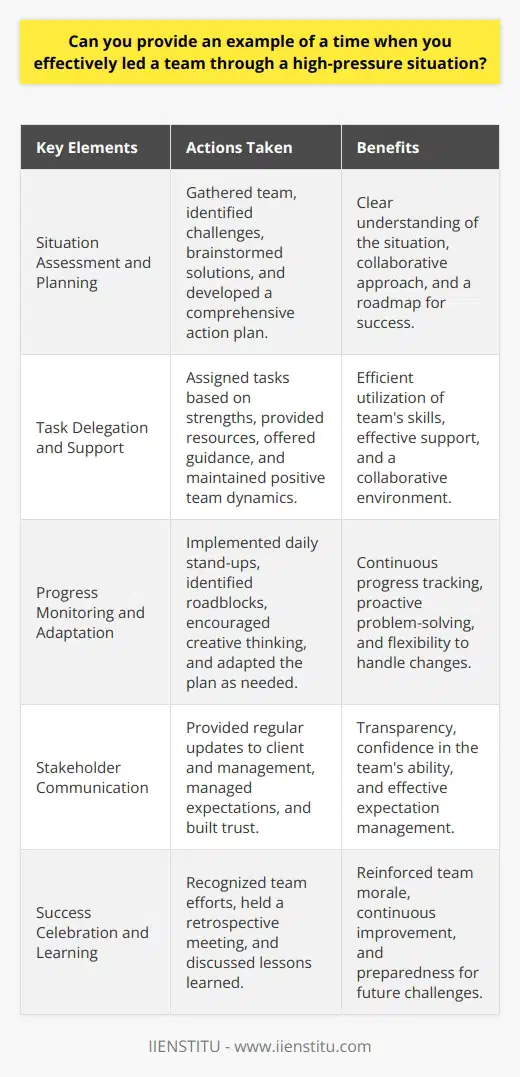
How have you managed a stressed team in the past?
Managing a stressed team requires a multifaceted approach that involves effective communication, empathy, and strategic problem-solving. In the past, I have successfully managed stressed teams by implementing several key strategies.
Fostering Open Communication
One of the most crucial aspects of managing a stressed team is maintaining open lines of communication. I encouraged team members to share their concerns and challenges openly. By creating a safe and non-judgmental environment, individuals felt more comfortable expressing their thoughts and feelings.
Regular check-ins and one-on-one meetings allowed me to gauge each team member's stress levels and address issues proactively. During these conversations, I actively listened and provided support and guidance tailored to their specific needs.
Prioritizing and Delegating Tasks
When a team is under stress, it is essential to prioritize tasks and delegate responsibilities effectively. I worked closely with the team to identify critical priorities and break them down into manageable action items.
By clearly defining roles and expectations, team members had a better understanding of their contributions and felt more in control of their workload. I also encouraged the team to collaborate and support each other, fostering a sense of camaraderie and shared responsibility.
Promoting Work-Life Balance
Recognizing the importance of work-life balance, I implemented initiatives to help team members manage stress and avoid burnout. This included encouraging regular breaks, setting realistic deadlines, and promoting a healthy work environment.
I also led by example, demonstrating the value of self-care and boundary-setting. By modeling healthy habits and prioritizing personal well-being, I inspired the team to do the same.
Providing Resources and Support
To further support the team during stressful periods, I ensured that they had access to necessary resources and support systems. This included providing training and development opportunities to enhance their skills and confidence.
I also connected team members with relevant employee assistance programs and mental health resources when needed. By showing genuine care for their well-being, I built trust and fostered a supportive team culture.
Celebrating Successes and Learning from Challenges
Even during stressful times, it is crucial to acknowledge and celebrate the team's successes. I made a point to regularly recognize individual and collective achievements, no matter how small.
When challenges arose, I encouraged the team to view them as opportunities for growth and learning. By fostering a growth mindset and promoting a culture of continuous improvement, the team became more resilient and adaptable in the face of stress.
Conclusion
Managing a stressed team requires a proactive and empathetic approach. By fostering open communication, prioritizing tasks, promoting work-life balance, providing resources, and celebrating successes, I have successfully navigated stressful periods and helped my team thrive.
Through these experiences, I have learned the importance of leading with compassion, adaptability, and a unwavering commitment to the well-being of my team members.

What strategies do you employ to alleviate stress within your team?
Effective stress management is crucial for maintaining a healthy and productive work environment within a team. Implementing strategies to alleviate stress can significantly improve team morale, performance, and overall well-being. This paragraph explores various approaches to managing stress within a team setting.
Promoting Open Communication
Encouraging open and honest communication among team members is essential for identifying and addressing sources of stress. Regular team meetings, one-on-one discussions, and anonymous feedback channels can help foster a supportive environment where individuals feel comfortable expressing their concerns and challenges. By actively listening and acknowledging the issues raised, team leaders can work collaboratively to find solutions and alleviate stress.
Prioritizing Work-Life Balance
Recognizing the importance of work-life balance is critical for reducing stress levels within a team. Encouraging team members to set boundaries between their professional and personal lives can prevent burnout and promote overall well-being. This can be achieved by establishing clear working hours, respecting time off, and discouraging excessive overtime. Additionally, offering flexible working arrangements, such as remote work options or adjustable schedules, can help team members better manage their responsibilities and reduce stress.
Providing Resources and Support
Equipping team members with the necessary resources and support systems is vital for stress management. This includes access to stress-reduction workshops, mental health resources, and employee assistance programs. Providing training on stress management techniques, such as mindfulness practices, time management skills, and relaxation exercises, can empower individuals to cope with stress effectively. Moreover, fostering a culture of peer support and mentorship can create a network of individuals who can offer guidance and support during challenging times.
Encouraging Breaks and Physical Activity
Promoting regular breaks and physical activity throughout the workday can help alleviate stress and improve overall well-being. Encouraging team members to step away from their workstations, take short walks, or engage in stretching exercises can provide mental and physical rejuvenation. Additionally, organizing team-building activities or social events that involve physical activity, such as group fitness classes or outdoor adventures, can foster a sense of camaraderie and reduce stress levels.
Recognizing and Celebrating Achievements
Acknowledging and celebrating the achievements of team members can significantly boost morale and reduce stress. Regularly recognizing individual and team successes, both big and small, can create a positive and motivating work environment. This can be done through verbal praise, written acknowledgments, or even small rewards. Celebrating milestones and accomplishments helps team members feel valued and appreciated, which can alleviate stress and foster a sense of purpose and fulfillment.
Conclusion
Implementing effective stress management strategies within a team requires a proactive and holistic approach. By promoting open communication, prioritizing work-life balance, providing resources and support, encouraging breaks and physical activity, and recognizing achievements, team leaders can create a supportive and stress-free work environment. Ultimately, investing in the well-being of team members leads to increased productivity, improved team dynamics, and overall success.

Can you describe a situation where you successfully helped a stressed team member?
Helping a stressed team member is a crucial aspect of maintaining a healthy and productive work environment. One instance where I successfully assisted a colleague who was under pressure occurred during a high-stakes project with a tight deadline. The team member, a software developer, was struggling to complete their assigned tasks due to the complexity of the coding requirements and the limited time available.
Identifying the Problem
I noticed that my colleague was visibly stressed and appeared to be overwhelmed by the workload. They were working long hours and seemed to be making little progress. I approached them during a break and asked if they needed any help or support. They confided in me that they were having difficulty with a specific part of the code and were worried about meeting the deadline.
Offering Support and Assistance
I reassured my colleague that it was okay to ask for help and that we were all part of a team. I offered to review their code and provide feedback or suggestions. We arranged a meeting where we could go through the problematic section of the code together. During the meeting, I listened attentively to their concerns and asked questions to better understand the issue.
Collaborating and Problem-Solving
Together, we broke down the complex problem into smaller, more manageable parts. We discussed potential solutions and brainstormed ideas. I shared some of my own experiences with similar coding challenges and suggested alternative approaches. We collaborated on writing a new section of the code, ensuring that it was efficient and met the project requirements.
Providing Encouragement and Recognition
Throughout the process, I made sure to provide encouragement and positive reinforcement to my colleague. I acknowledged their skills and expertise and reminded them that everyone faces challenges at times. I also made sure to recognize their contributions to the team and the project.
The Outcome
As a result of our collaboration and support, my colleague was able to overcome the coding challenge and complete their assigned tasks on time. They expressed gratitude for the assistance and felt more confident in their abilities. The project was successfully delivered, and the team celebrated the achievement together.
Lessons Learned
This experience taught me the importance of being attentive to the well-being of team members and offering support when needed. It highlighted the value of collaboration, communication, and problem-solving in overcoming challenges. It also reinforced the significance of creating a supportive and inclusive work environment where individuals feel comfortable seeking help and working together towards common goals.
In conclusion, successfully helping a stressed team member requires a combination of empathy, active listening, and a willingness to collaborate and problem-solve. By offering support, encouragement, and recognition, we can foster a positive team dynamic and ensure that everyone feels valued and supported in their work.
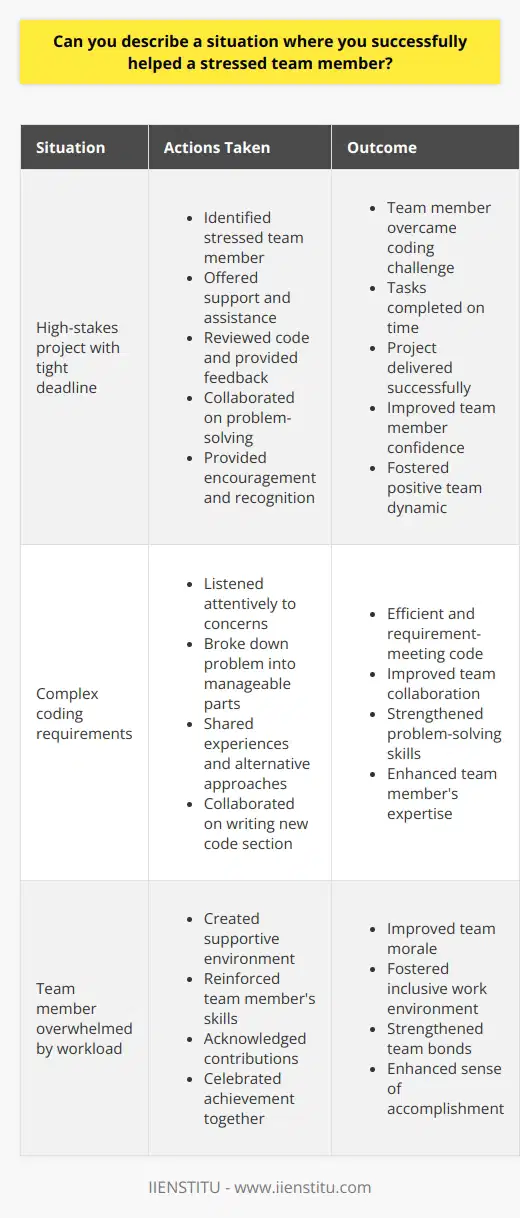
How do you typically cope with stress and pressure in the workplace?
Coping with stress and pressure in the workplace is a crucial skill for maintaining productivity and well-being. There are various strategies that individuals typically employ to manage these challenges effectively. One common approach is to prioritize tasks and create a structured plan to tackle them systematically. By breaking down larger projects into smaller, manageable steps, individuals can reduce feelings of overwhelm and maintain a sense of control over their workload.
Effective Time Management
Another essential coping mechanism is effective time management. By allocating specific time slots for different tasks and setting realistic deadlines, individuals can ensure that they are using their time efficiently. This approach helps to minimize procrastination and reduces the likelihood of last-minute rushes, which can exacerbate stress levels. Additionally, taking regular breaks throughout the day can help to recharge and refocus the mind, enabling individuals to approach their work with renewed energy and clarity.
Seeking Support
Seeking support from colleagues, supervisors, or mentors is also a valuable strategy for coping with stress and pressure. By communicating openly about challenges and seeking guidance when needed, individuals can tap into the expertise and experience of others. This collaborative approach not only helps to problem-solve and generate new ideas but also fosters a sense of camaraderie and shared purpose within the workplace.
Maintaining Work-Life Balance
Maintaining a healthy work-life balance is another crucial aspect of coping with stress and pressure. Engaging in activities outside of work, such as exercise, hobbies, or spending time with loved ones, can provide a much-needed respite from the demands of the job. These activities help to promote relaxation, reduce stress levels, and maintain a sense of perspective. By setting clear boundaries between work and personal life, individuals can ensure that they have the time and space to recharge and pursue their own interests.
Cultivating Resilience
Cultivating a sense of resilience is also essential for coping with stress and pressure in the workplace. This involves developing a growth mindset, embracing challenges as opportunities for learning and development, and maintaining a positive outlook in the face of adversity. By focusing on their strengths and accomplishments, individuals can build a sense of self-efficacy and confidence in their ability to overcome obstacles.
Practicing Mindfulness
Finally, practicing mindfulness techniques, such as deep breathing, meditation, or yoga, can be highly effective in managing stress and pressure. These practices help to calm the mind, reduce anxiety, and promote a sense of inner peace and clarity. By incorporating mindfulness into their daily routine, individuals can develop greater emotional regulation and resilience in the face of workplace challenges.
Conclusion
In conclusion, coping with stress and pressure in the workplace requires a multifaceted approach that encompasses effective time management, seeking support, maintaining work-life balance, cultivating resilience, and practicing mindfulness. By employing these strategies consistently and proactively, individuals can navigate the demands of their job with greater ease and maintain a sense of well-being and fulfillment in their professional lives.
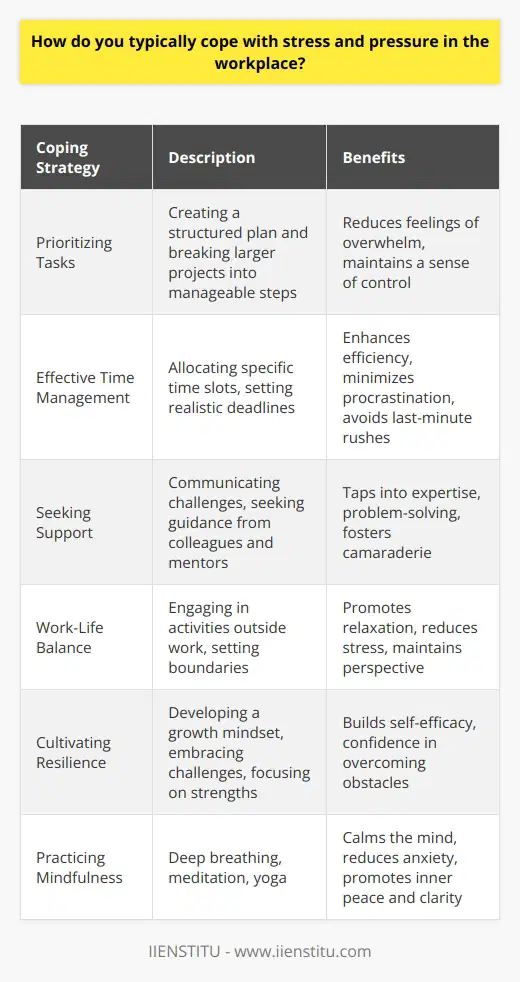
What strategies have you found most effective in managing stress and pressure?
Effective stress management strategies vary from person to person, but several techniques have proven consistently beneficial. Regular exercise, such as brisk walking or yoga, can significantly reduce stress levels by releasing endorphins and improving overall well-being. Practicing mindfulness meditation helps individuals focus on the present moment, reducing anxiety about future events or past experiences. Engaging in hobbies or activities that bring joy and relaxation, like reading, painting, or gardening, can provide a much-needed break from stressful situations.
Time Management and Organization
Implementing effective time management strategies can help alleviate stress caused by overwhelming workloads or tight deadlines. Prioritizing tasks based on urgency and importance allows individuals to focus on critical responsibilities first. Breaking larger projects into smaller, manageable steps makes them less daunting and more achievable. Maintaining a clean and organized workspace can also contribute to reduced stress levels, as clutter can be visually and mentally distracting.
Social Support and Communication
Building a strong support system of friends, family, or colleagues can provide a valuable outlet for discussing stressors and seeking advice. Sharing concerns with trusted individuals can help put problems into perspective and generate potential solutions. Effective communication skills, such as active listening and assertiveness, can help resolve conflicts and minimize interpersonal stress. Joining support groups or seeking professional counseling can also provide guidance and coping strategies for managing stress.
Lifestyle Choices and Self-Care
Making healthy lifestyle choices can significantly impact stress levels and overall well-being. Maintaining a balanced diet rich in fruits, vegetables, and whole grains provides the necessary nutrients to support mental and physical health. Limiting caffeine and alcohol intake can help reduce anxiety and improve sleep quality. Establishing a consistent sleep schedule and aiming for 7-9 hours of sleep per night can improve stress resilience and cognitive function.
Boundary Setting and Relaxation Techniques
Setting clear boundaries between work and personal life can help prevent stress from spilling over into other areas. Learning to say "no" to non-essential commitments can free up time for self-care and relaxation. Incorporating relaxation techniques, such as deep breathing exercises or progressive muscle relaxation, can help reduce tension and promote a sense of calm. Engaging in activities that promote mindfulness, like yoga or tai chi, can also be effective stress management tools.
Reframing Thoughts and Embracing Flexibility
Reframing negative thoughts and adopting a more positive outlook can help individuals cope with stressful situations. Challenging irrational beliefs and focusing on what can be controlled can reduce anxiety and improve problem-solving skills. Embracing flexibility and adaptability can also help individuals navigate unexpected challenges with greater ease. Recognizing that change is inevitable and being open to alternative solutions can reduce stress associated with rigid expectations.
Conclusion
Effectively managing stress and pressure requires a multifaceted approach tailored to individual needs and preferences. Incorporating a combination of exercise, mindfulness, time management, social support, healthy lifestyle choices, boundary setting, relaxation techniques, and positive thinking can help individuals build resilience and cope with stress more successfully. By prioritizing self-care and adopting effective stress management strategies, individuals can improve their overall well-being and navigate life's challenges with greater ease.

In high-pressure situations, how do you maintain your composure and focus to handle stress successfully?
Maintaining composure and focus in high-pressure situations is crucial for handling stress successfully. One effective strategy is to practice mindfulness and deep breathing exercises. Taking slow, deep breaths can help calm the nervous system and reduce anxiety. Focusing on the present moment and acknowledging one's thoughts and emotions without judgment can also promote a sense of clarity and control.
Preparation and Planning
Another key aspect of managing stress in high-pressure situations is adequate preparation and planning. Breaking down complex tasks into smaller, manageable steps can make them feel less overwhelming. Setting realistic goals and prioritizing tasks based on their importance and urgency can help individuals stay organized and focused. It is also beneficial to anticipate potential challenges and develop contingency plans to address them proactively.
Positive Self-Talk and Reframing
Engaging in positive self-talk and reframing negative thoughts can significantly impact one's ability to handle stress. Instead of dwelling on worst-case scenarios or self-doubt, individuals should remind themselves of their strengths, past successes, and resilience. Reframing stressful situations as opportunities for growth and learning can help shift one's mindset from a state of helplessness to a state of empowerment.
Support Systems and Self-Care
Building a strong support system is essential for maintaining composure and focus under pressure. Seeking guidance and encouragement from trusted colleagues, mentors, or loved ones can provide valuable perspective and emotional support. Additionally, prioritizing self-care practices such as regular exercise, healthy eating, and sufficient sleep can enhance overall well-being and stress resilience.
Adaptability and Flexibility
In high-pressure situations, it is important to remain adaptable and flexible. Circumstances may change unexpectedly, and individuals who can quickly adjust their approach and strategies are better equipped to handle stress. Embracing a growth mindset and viewing challenges as opportunities to learn and improve can foster a sense of resilience and adaptability.
By implementing these strategies, individuals can cultivate the skills necessary to maintain composure and focus in high-pressure situations. With practice and persistence, handling stress successfully can become a more manageable and empowering experience.
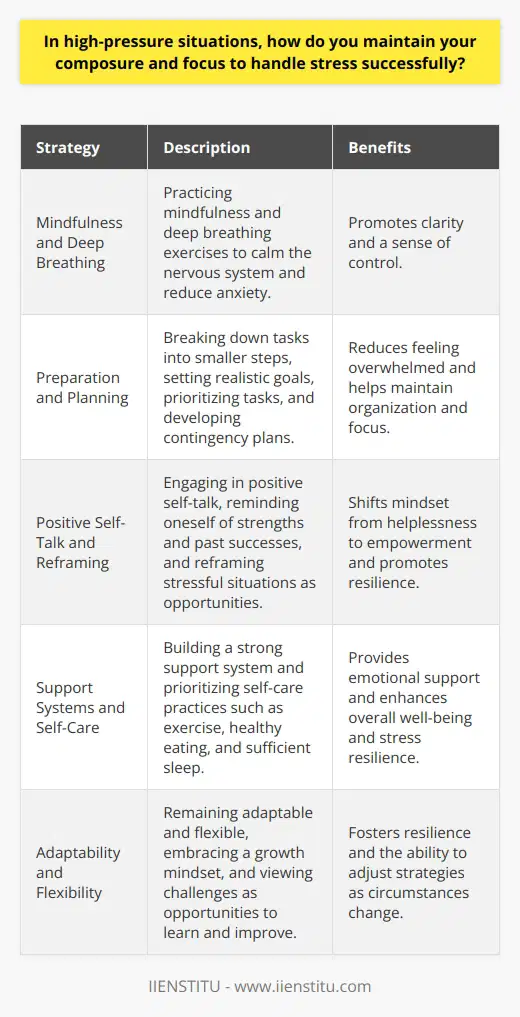
How have you effectively managed a team under high stress in the past?
Effective team management under high stress requires a combination of strong leadership, clear communication, and adaptability. In the past, I have successfully managed teams during challenging situations by implementing several key strategies.
Establishing Clear Goals and Expectations
One of the most critical aspects of managing a team under stress is setting clear goals and expectations. When team members understand their roles and responsibilities, they can focus on their tasks without ambiguity. I ensure that each team member knows what is expected of them and how their work contributes to the overall project success.
Breaking Down Tasks
To make goals more manageable, I break down larger tasks into smaller, achievable milestones. This approach helps team members feel less overwhelmed and allows them to track their progress more easily. Celebrating small wins along the way boosts morale and keeps the team motivated.
Fostering Open Communication
Open and transparent communication is essential for managing a team under high stress. I encourage team members to voice their concerns, share ideas, and provide feedback regularly. By creating a safe and supportive environment, team members feel more comfortable discussing challenges and working together to find solutions.
Regular Check-Ins
I schedule regular check-ins with team members to assess their progress, address any obstacles, and provide support. These check-ins can be one-on-one meetings or team huddles, depending on the situation. Regular communication helps identify potential issues early on and allows for timely course corrections.
Leading by Example
As a team leader, I believe in leading by example. I maintain a calm and composed demeanor, even under high stress, to inspire confidence in my team. I actively participate in problem-solving sessions and demonstrate a willingness to roll up my sleeves and work alongside my team when needed.
Promoting Work-Life Balance
Recognizing that high stress can lead to burnout, I prioritize the well-being of my team members. I encourage them to take breaks when needed, maintain a healthy work-life balance, and engage in stress-reducing activities. A well-rested and mentally healthy team is more productive and better equipped to handle challenges.
Adaptability and Contingency Planning
In high-stress situations, adaptability is key. I remain flexible and open to adjusting plans as circumstances change. By anticipating potential roadblocks and creating contingency plans, I help my team stay prepared for unexpected challenges.
Encouraging Creativity and Innovation
I foster an environment that encourages creativity and innovation, even under stress. I believe that challenging times often lead to the most innovative solutions. By empowering team members to think outside the box and share their ideas, we can find new ways to overcome obstacles and achieve our goals.
Managing a team under high stress requires a proactive, empathetic, and adaptable leadership approach. By setting clear goals, fostering open communication, leading by example, promoting well-being, and encouraging innovation, I have successfully navigated challenging situations and helped my team thrive under pressure.
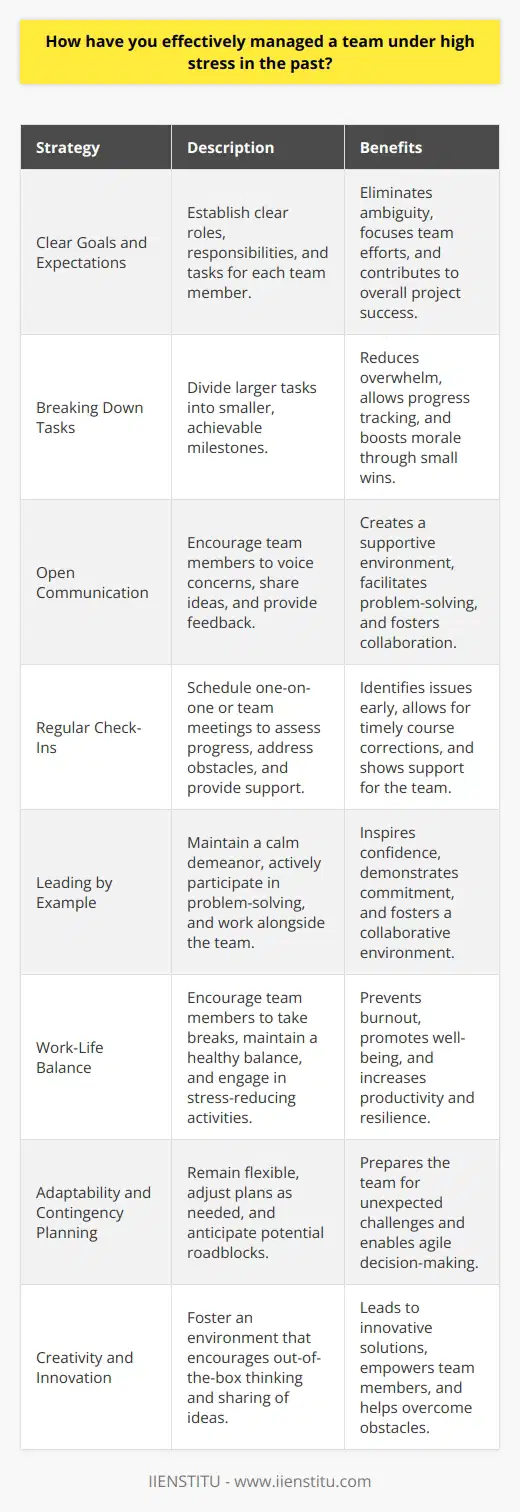
Can you provide specific examples of strategies you've used to support a stressed team?
Supporting a stressed team requires a multifaceted approach that addresses both individual and collective needs. One effective strategy is to foster open communication and create a safe space for team members to express their concerns and challenges. This can be achieved through regular one-on-one check-ins, team meetings, and anonymous feedback channels. By actively listening and validating their experiences, leaders can demonstrate empathy and build trust within the team.
Prioritizing Mental Health and Well-being
Recognizing the importance of mental health is crucial in supporting a stressed team. Encouraging team members to prioritize self-care and offering resources such as access to mental health professionals, mindfulness workshops, or stress management training can help individuals cope with stress more effectively. Additionally, promoting a healthy work-life balance by setting clear boundaries, encouraging time off, and respecting personal time can prevent burnout and maintain team morale.
Collaborative Problem-Solving
Engaging the team in collaborative problem-solving can alleviate stress by fostering a sense of control and ownership. When faced with challenging situations, involve team members in brainstorming sessions to identify potential solutions and develop action plans. By leveraging the collective knowledge and expertise of the team, leaders can distribute the workload and empower individuals to contribute to resolving stressful situations.
Providing Clarity and Structure
Stress often arises from uncertainty and lack of direction. To mitigate this, leaders should provide clear goals, expectations, and priorities. Breaking down complex projects into manageable tasks and setting realistic deadlines can help team members feel more in control and less overwhelmed. Regular updates and progress reviews can also keep everyone aligned and informed, reducing stress caused by ambiguity.
Celebrating Successes and Offering Recognition
Acknowledging and celebrating the team's achievements, no matter how small, can boost morale and reduce stress. Regularly expressing appreciation for individual contributions and team efforts can foster a positive and supportive work environment. Recognizing milestones, sharing success stories, and providing meaningful rewards or incentives can help team members feel valued and motivated, even during challenging times.
Promoting Resilience and Adaptability
Equipping team members with the skills and mindset to navigate change and uncertainty is essential for long-term stress management. Providing training and development opportunities that focus on resilience, adaptability, and emotional intelligence can help individuals build their capacity to cope with stress. Encouraging a growth mindset and framing challenges as opportunities for learning and growth can shift the team's perspective and reduce stress-induced paralysis.
By implementing these strategies and leading with empathy and compassion, leaders can create a supportive and resilient team environment that effectively manages stress and fosters well-being.

In your experience, what are the key factors in successfully leading a team through challenging and stressful situations?
Successfully leading a team through challenging and stressful situations requires a combination of several key factors. Effective communication is essential for ensuring that all team members understand their roles, responsibilities, and objectives. Leaders must be able to clearly articulate the goals and expectations while also being open to feedback and suggestions from the team. Transparency and honesty in communication help build trust and foster a sense of unity among team members.
Adaptability and Flexibility
In challenging situations, leaders must be adaptable and flexible to navigate the complexities and uncertainties that arise. They should be able to quickly assess the situation, make informed decisions, and adjust strategies as needed. Leaders who are rigid in their approach or unwilling to consider alternative solutions may struggle to effectively guide their team through difficult times. Being open to new ideas and approaches can help teams find creative solutions to problems and maintain their effectiveness.
Emotional Intelligence and Empathy
Emotional intelligence is a crucial factor in successfully leading a team through stressful situations. Leaders with high emotional intelligence are attuned to the emotions and needs of their team members. They can recognize signs of stress, anxiety, or burnout and provide appropriate support and resources. Empathy allows leaders to understand and relate to the challenges their team members face, creating a supportive and understanding environment. When team members feel understood and supported, they are more likely to remain engaged and motivated, even in difficult circumstances.
Resilience and Perseverance
Challenging situations often require resilience and perseverance from both leaders and team members. Leaders who demonstrate resilience and maintain a positive outlook can inspire their team to keep pushing forward despite setbacks or obstacles. Encouraging a growth mindset and emphasizing the importance of learning from failures can help teams develop resilience. Leaders should also recognize and celebrate small victories along the way to maintain morale and motivation.
Clear Priorities and Decision-Making
In stressful situations, it is essential for leaders to establish clear priorities and make timely decisions. They should be able to identify the most critical tasks and allocate resources accordingly. Leaders who can make difficult decisions under pressure and communicate those decisions effectively can help their team stay focused and aligned. Involving team members in the decision-making process, when appropriate, can also promote a sense of ownership and engagement.
Delegation and Empowerment
Effective leaders understand the importance of delegation and empowerment in managing challenging situations. They recognize the strengths and skills of their team members and delegate tasks accordingly. Empowering team members to take ownership of their work and make decisions within their areas of expertise can help distribute the workload and foster a sense of trust and autonomy. Leaders who micromanage or fail to delegate effectively may struggle to lead their team through difficult times.
Continuous Learning and Improvement
Finally, successful leaders in challenging situations are committed to continuous learning and improvement. They seek feedback from their team members, reflect on their own performance, and actively look for ways to enhance their leadership skills. Encouraging a culture of learning and growth within the team can help foster innovation, adaptability, and resilience. Leaders who are open to feedback and willing to learn from their experiences are better equipped to guide their team through future challenges.
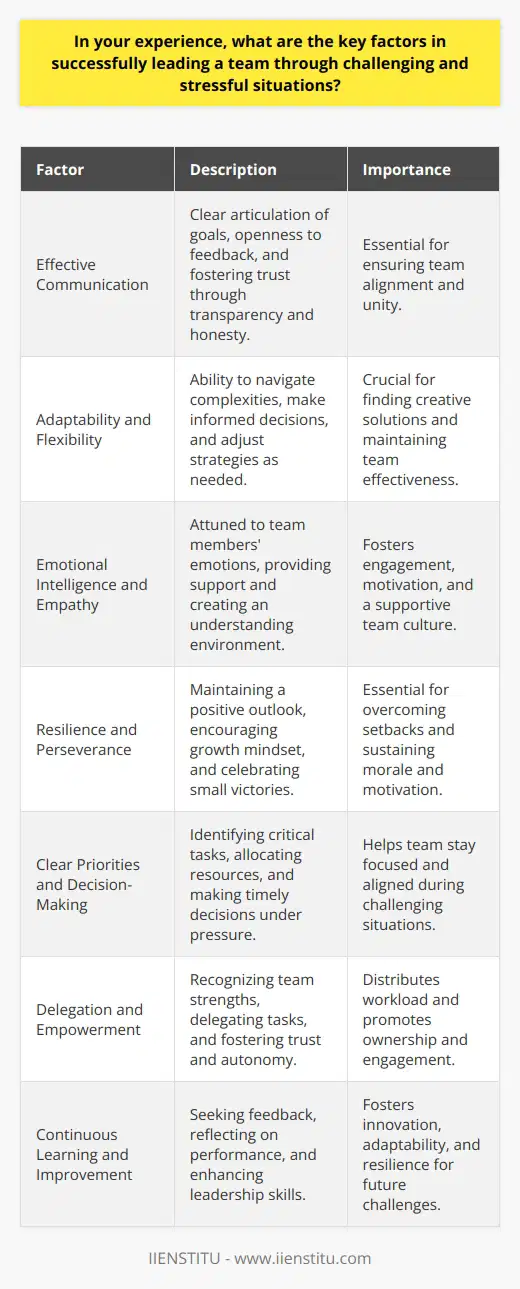
How have you handled leading a team that was under a lot of stress?
Leading a team under a lot of stress requires a multifaceted approach that addresses both individual and collective needs. As a leader, it is essential to recognize the signs of stress within the team and take proactive measures to mitigate its impact on performance and well-being. One of the key strategies I have employed is fostering open communication channels that encourage team members to express their concerns and challenges openly.
Promoting Open Communication
By creating a safe and supportive environment, team members feel more comfortable sharing their struggles and seeking assistance when needed. Regular one-on-one meetings and team discussions provide opportunities to identify stressors and collaborate on solutions. Additionally, I make a conscious effort to listen actively and empathetically to my team's concerns, acknowledging their feelings and experiences without judgment.
Prioritizing Work-Life Balance
Another crucial aspect of managing a stressed team is promoting work-life balance. Encouraging team members to take regular breaks, disconnect from work outside of office hours, and engage in stress-reducing activities can significantly improve their overall well-being. I lead by example, demonstrating the importance of self-care and setting clear boundaries between work and personal life.
Implementing Flexible Work Arrangements
Offering flexible work arrangements, such as remote work options or adjustable schedules, can also help alleviate stress. By providing team members with greater control over their work environment and schedule, they can better manage their personal responsibilities and maintain a healthier work-life balance.
Fostering a Positive Team Culture
Creating a positive and supportive team culture is essential for managing stress. I strive to cultivate an environment that values collaboration, mutual respect, and recognition of individual contributions. Celebrating successes, both big and small, helps boost morale and foster a sense of accomplishment within the team.
Organizing Team-Building Activities
Engaging in regular team-building activities, such as group outings or skill-sharing sessions, can strengthen interpersonal relationships and promote a sense of camaraderie. These activities provide opportunities for team members to connect on a personal level, share experiences, and support one another through challenging times.
Providing Resources and Support
As a leader, it is crucial to ensure that team members have access to the resources and support they need to manage stress effectively. This may include offering stress management workshops, providing access to employee assistance programs, or connecting team members with mental health professionals when necessary.
Encouraging Professional Development
Investing in the professional development of team members can also help reduce stress by equipping them with new skills and knowledge to handle their responsibilities more effectively. By providing opportunities for learning and growth, leaders can help team members feel more confident and capable in their roles.
In summary, leading a team under a lot of stress requires a proactive and empathetic approach that prioritizes open communication, work-life balance, a positive team culture, and access to resources and support. By implementing these strategies consistently and leading by example, leaders can help their teams navigate challenging times and maintain high levels of performance and well-being.
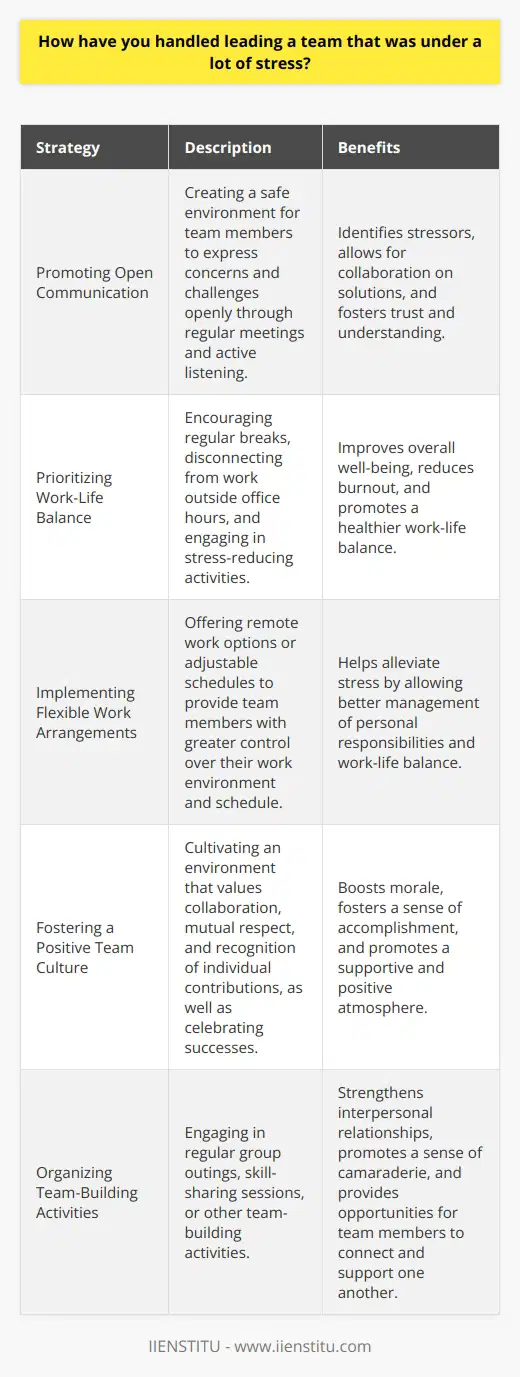
What strategies have you employed to manage a team during high-pressure situations?
Managing a team during high-pressure situations requires a combination of effective strategies to ensure successful outcomes. One crucial approach is maintaining open and transparent communication channels with team members. Regularly updating the team on project progress, challenges, and expectations helps keep everyone informed and aligned. Conducting brief daily stand-up meetings facilitates quick information sharing and problem-solving. Additionally, actively listening to team members' concerns and ideas promotes a sense of trust and collaboration.
Prioritizing and Delegating Tasks
Effective prioritization and delegation of tasks are essential during high-pressure situations. Clearly defining priorities based on urgency and importance helps the team focus on critical tasks. Assigning tasks to team members based on their skills and capabilities optimizes efficiency and results. Providing clear instructions and deadlines ensures everyone understands their responsibilities. Regularly monitoring progress and offering support when needed keeps the team on track.
Promoting a Positive Team Environment
Fostering a positive team environment is crucial during challenging times. Recognizing and appreciating team members' efforts boosts morale and motivation. Celebrating small wins and milestones keeps the team energized and focused. Encouraging a supportive and collaborative atmosphere where team members help each other promotes unity. Leading by example, remaining calm, and maintaining a positive attitude inspires the team to persevere.
Encouraging Work-Life Balance
High-pressure situations often lead to increased workload and stress. Encouraging a healthy work-life balance helps prevent burnout and maintains team productivity. Promoting reasonable working hours and discouraging excessive overtime shows concern for team members' well-being. Encouraging breaks, stress-relief activities, and team-building exercises helps reduce tension and fosters a positive work environment. Regularly checking in with team members and offering support demonstrates empathy and understanding.
Continuously Learning and Adapting
Managing a team during high-pressure situations requires continuous learning and adaptation. Regularly seeking feedback from team members helps identify areas for improvement and address concerns promptly. Encouraging open discussions and brainstorming sessions promotes innovative problem-solving approaches. Staying updated on industry best practices and emerging trends enhances the team's capabilities. Embracing flexibility and being open to adjusting strategies based on changing circumstances ensures the team remains agile and responsive.
By employing these strategies, managers can effectively lead their teams through high-pressure situations. Maintaining open communication, prioritizing tasks, promoting a positive environment, encouraging work-life balance, and continuously learning and adapting are key to success. With the right approach and leadership, teams can overcome challenges, deliver exceptional results, and emerge stronger from high-pressure situations.
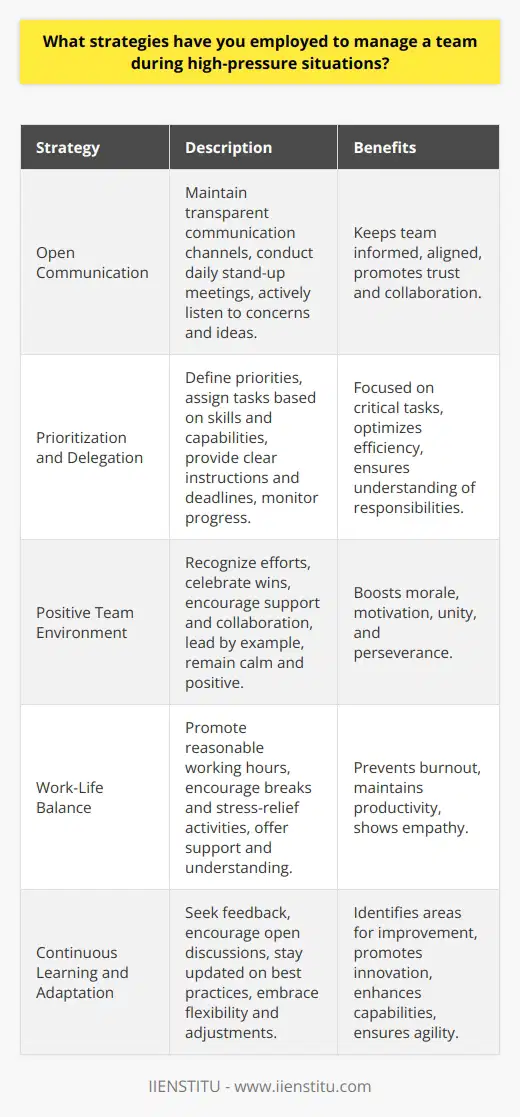
Can you describe a time when you successfully navigated a team through a particularly stressful period?
Navigating a team through a stressful period requires effective leadership, communication, and problem-solving skills. One such instance occurred during a crucial project deadline at my previous workplace. As the team leader, I recognized the signs of stress and anxiety among my team members. To address this, I implemented several strategies to maintain morale and productivity.
Establishing Clear Communication
I began by establishing clear lines of communication within the team. I organized daily stand-up meetings to discuss progress, challenges, and concerns. These meetings provided a platform for team members to voice their opinions and seek support. I actively listened to their concerns and offered guidance and reassurance. By maintaining transparency and open dialogue, I fostered a sense of trust and collaboration among the team.
Prioritizing Tasks and Delegating Responsibilities
To alleviate the workload and stress, I prioritized tasks based on their urgency and importance. I worked with the team to create a detailed action plan, breaking down complex tasks into manageable steps. I delegated responsibilities according to each team member's strengths and expertise. This approach ensured that everyone had a clear understanding of their roles and felt empowered to contribute effectively.
Providing Support and Resources
I recognized that my team needed additional support and resources to navigate the stressful period successfully. I arranged for training sessions to enhance their skills and knowledge in relevant areas. I also secured the necessary tools and resources to streamline their work processes. By investing in their development and providing them with the right tools, I demonstrated my commitment to their success and well-being.
Promoting Work-Life Balance
To prevent burnout and maintain a healthy work environment, I encouraged my team to prioritize their work-life balance. I implemented flexible working hours and encouraged them to take short breaks throughout the day. I also organized team-building activities and social events to foster a sense of camaraderie and provide a much-needed break from the intense work pressure.
Celebrating Milestones and Successes
Throughout the stressful period, I made sure to acknowledge and celebrate the team's milestones and successes. I regularly praised their efforts and accomplishments during team meetings and through personal feedback. By recognizing their hard work and dedication, I boosted their morale and motivation to push through the challenging times.
Outcome and Lessons Learned
As a result of these strategies, my team successfully navigated the stressful period and delivered the project on time. The experience taught me valuable lessons in leadership, adaptability, and the importance of prioritizing team well-being. I learned that by creating a supportive and collaborative environment, a team can overcome even the most challenging circumstances.
In conclusion, successfully navigating a team through a stressful period requires a multifaceted approach. By establishing clear communication, prioritizing tasks, providing support and resources, promoting work-life balance, and celebrating successes, leaders can guide their teams towards success while maintaining a positive and resilient work culture.
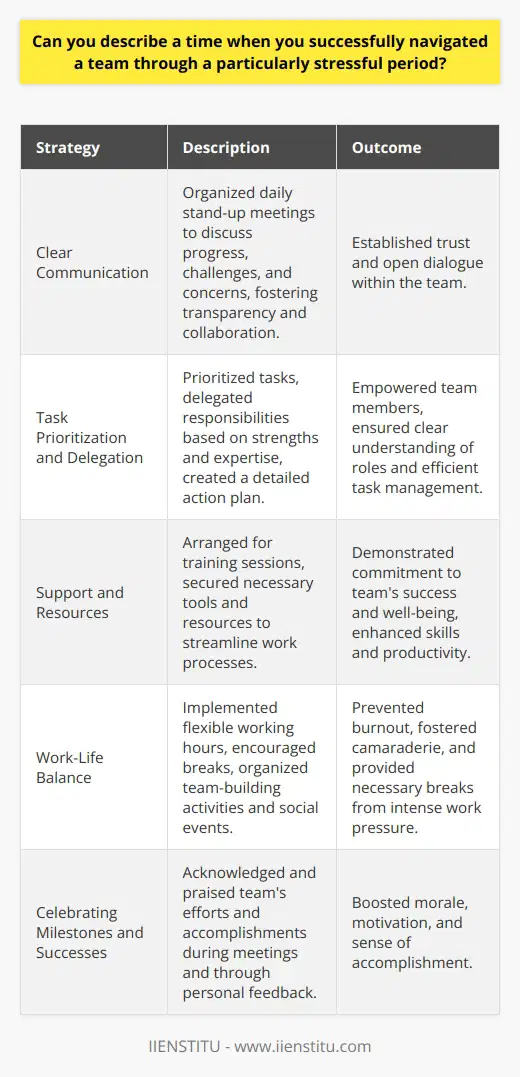
What are some common sample stress interview questions?
Stress interviews are designed to assess a candidate's ability to handle pressure and think on their feet. These interviews often include questions that are intentionally challenging or seemingly impossible to answer. Some common sample stress interview questions include:
Handling Conflict
Interviewers may ask about a time when you had to deal with a difficult colleague or customer. They want to know how you manage conflict and maintain professionalism under pressure. An example question could be, "Tell me about a time when you had to work with someone you didn't like."
Responding to Criticism
Stress interviews often involve questions that challenge your past decisions or performance. The interviewer may ask, "Why did you choose to handle a situation in that particular way?" or "What would you do differently if faced with a similar challenge?" These questions test your ability to accept constructive criticism and learn from your experiences.
Addressing Weaknesses
Interviewers may ask about your weaknesses or areas where you need improvement. They want to see if you have self-awareness and are actively working on personal growth. A question might be, "What is your biggest weakness, and how are you addressing it?"
Solving Hypothetical Problems
Stress interviews often include hypothetical scenarios that require quick thinking and problem-solving skills. The interviewer may present a challenging situation and ask how you would handle it. For example, "If you were managing a project and realized you would miss the deadline, what would you do?"
Responding to Unexpected Questions
Interviewers may ask seemingly unrelated or bizarre questions to see how you react to the unexpected. These questions can range from silly to thought-provoking. An example might be, "If you were a kitchen appliance, which one would you be and why?"
Demonstrating Resilience
Stress interviews often involve questions that probe your ability to bounce back from setbacks. The interviewer may ask about a time when you failed at something and how you handled it. They want to see if you can learn from your mistakes and maintain a positive attitude.
Staying Calm Under Pressure
Throughout the stress interview, the interviewer will observe how you handle the pressure of challenging questions. They may ask multiple questions in rapid succession or interrupt you while you're speaking. The key is to remain calm, take a moment to think before responding, and maintain a professional demeanor.
By preparing for these common types of stress interview questions, you can increase your chances of performing well under pressure. Remember to stay confident, maintain eye contact, and take deep breaths if needed. With practice and persistence, you can master the art of handling stress interviews and demonstrate your ability to thrive in challenging work environments.

How can I effectively answer sample stress interview questions?
Answering sample stress interview questions effectively requires preparation, self-awareness, and the ability to remain calm under pressure. To begin, research common stress interview questions and practice your responses ahead of time. This will help you feel more confident and less anxious during the actual interview. When answering these questions, focus on highlighting your problem-solving skills, adaptability, and resilience. Provide specific examples from your past experiences that demonstrate how you successfully handled stressful situations. It's important to be honest and authentic in your responses, as interviewers can often detect insincere or rehearsed answers.
Maintain a Positive Attitude
Maintaining a positive attitude is crucial when facing stress interview questions. Avoid complaining or speaking negatively about past experiences, even if they were challenging. Instead, emphasize the lessons you learned and how they have contributed to your personal and professional growth. Demonstrate enthusiasm for the opportunity and express your willingness to take on new challenges. A positive outlook will show the interviewer that you have the right mindset to handle the demands of the role.
Practice Stress-Management Techniques
Incorporating stress-management techniques into your interview preparation can help you stay composed during high-pressure moments. Deep breathing exercises, meditation, and visualization techniques can all be useful tools for reducing anxiety and maintaining focus. During the interview, take a moment to collect your thoughts before responding to difficult questions. Speak slowly and clearly, and don't be afraid to ask for clarification if needed. Remember that the interviewer is not trying to catch you off guard, but rather assess how you perform under pressure.
Showcase Your Problem-Solving Skills
Stress interview questions often present hypothetical scenarios that require quick thinking and problem-solving skills. When answering these questions, demonstrate your ability to analyze the situation, identify key issues, and propose practical solutions. Use the STAR method (Situation, Task, Action, Result) to structure your responses and provide concrete examples of how you have successfully navigated challenging situations in the past. Highlight your ability to remain level-headed and focus on finding solutions, even in high-pressure environments.
Emphasize Your Adaptability and Resilience
Adaptability and resilience are essential qualities that employers seek in candidates, particularly for roles that involve high levels of stress. When answering stress interview questions, emphasize your ability to adapt to changing circumstances and bounce back from setbacks. Share examples of times when you had to pivot your approach or overcome obstacles to achieve your goals. Demonstrate your willingness to learn from your mistakes and use them as opportunities for growth and development.
In conclusion, effectively answering sample stress interview questions requires a combination of preparation, self-awareness, and the ability to showcase your problem-solving skills, adaptability, and resilience. By maintaining a positive attitude, practicing stress-management techniques, and providing specific examples of how you have successfully handled challenging situations in the past, you can demonstrate to the interviewer that you have the right qualities to thrive in a high-pressure role.
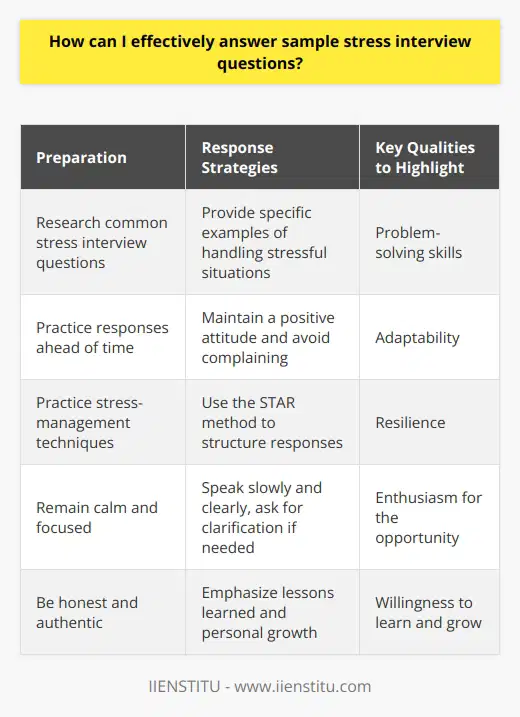
What strategies can I use to prepare for sample stress interview questions?
To effectively prepare for sample stress interview questions, you can employ several strategies. First, research common stress interview questions and familiarize yourself with their format and purpose. This will help you understand the types of questions you may encounter during the interview process. Additionally, practice answering these questions out loud, either alone or with a partner, to build confidence and improve your responses.
Develop a Positive Mindset
Maintaining a positive mindset is crucial when preparing for stress interviews. Recognize that the interviewer's goal is not to intimidate you but rather to assess your ability to handle pressure and think critically under stress. Embrace the challenge as an opportunity to showcase your skills and resilience. By adopting a positive attitude, you can approach the interview with greater confidence and composure.
Practice Stress Management Techniques
Incorporating stress management techniques into your preparation can help you remain calm and focused during the interview. Deep breathing exercises, meditation, and visualization can be effective tools for reducing anxiety and maintaining a clear mind. Regularly practicing these techniques will enhance your ability to manage stress in high-pressure situations, allowing you to perform at your best during the interview.
Anticipate and Prepare for Different Scenarios
Stress interviews often involve unexpected or challenging scenarios. To prepare, brainstorm potential scenarios you may face and develop strategies to address them effectively. Consider how you would respond to difficult questions, handle confrontational statements, or solve problems under pressure. By anticipating and preparing for various scenarios, you can enter the interview with a well-rounded approach and the ability to adapt to different situations.
Focus on Your Strengths and Accomplishments
When answering stress interview questions, focus on highlighting your strengths and accomplishments. Identify specific examples from your past experiences that demonstrate your ability to handle stress, solve problems, and achieve positive outcomes. By emphasizing your strengths and providing concrete evidence of your capabilities, you can instill confidence in the interviewer and showcase your suitability for the role.
Practice Active Listening and Clear Communication
During the interview, practice active listening and clear communication. Pay close attention to the questions being asked and take a moment to collect your thoughts before responding. Speak clearly and concisely, avoiding rambling or getting sidetracked. If you need clarification on a question, don't hesitate to ask for it. By demonstrating strong communication skills, you can effectively convey your ideas and engage in a productive dialogue with the interviewer.
Seek Feedback and Learn from Each Experience
After each mock interview or real interview experience, take time to reflect on your performance. Seek feedback from others, such as mentors or trusted colleagues, to identify areas for improvement. Analyze your strengths and weaknesses, and use this knowledge to refine your interview skills. By continuously learning and adapting based on feedback, you can enhance your ability to handle stress interviews and increase your chances of success.
Remember, preparation is key to excelling in stress interviews.
By researching common questions, developing a positive mindset, practicing stress management techniques, anticipating scenarios, focusing on your strengths, enhancing communication skills, and learning from each experience, you can effectively prepare for sample stress interview questions and increase your confidence in handling high-pressure situations.
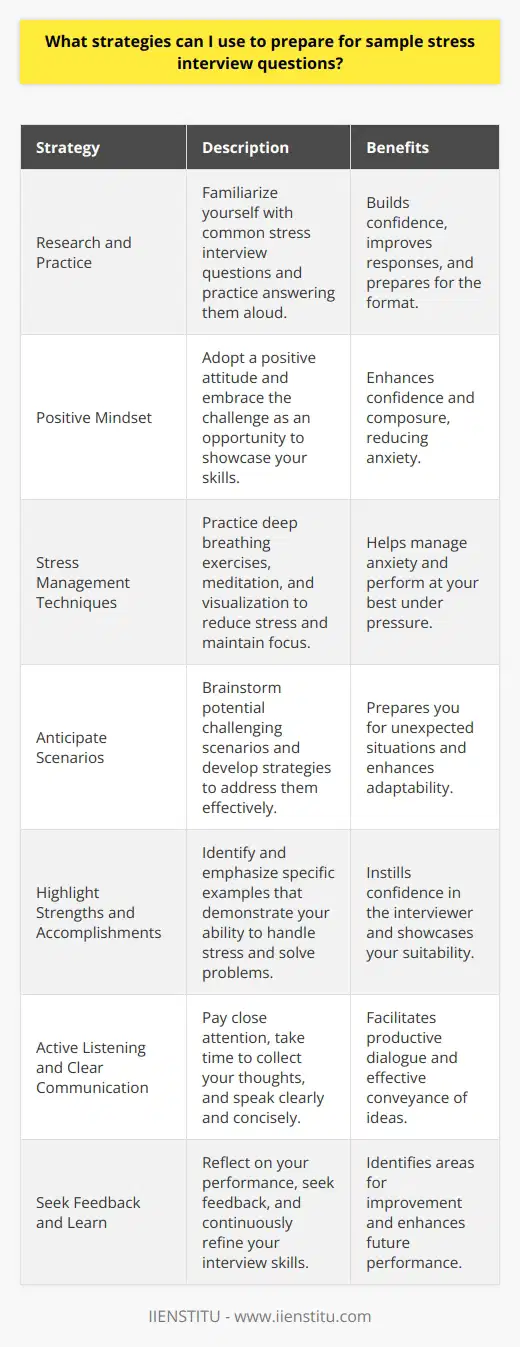
How do you typically handle stress and pressure in the workplace?
Stress and pressure are common challenges in the workplace that require effective strategies to maintain productivity and well-being. One typical approach to handling these challenges is through proper time management and prioritization. By identifying and focusing on the most critical tasks, individuals can reduce feelings of being overwhelmed and ensure that important responsibilities are met.
Another effective strategy is to practice stress-reduction techniques, such as deep breathing exercises or mindfulness meditation. These practices can help calm the mind, reduce anxiety, and improve overall focus and clarity. Additionally, taking short breaks throughout the day can provide mental and physical respite, allowing individuals to recharge and approach tasks with renewed energy.
Maintaining a Healthy Work-Life Balance
Establishing and maintaining a healthy work-life balance is crucial for managing stress and pressure in the workplace. This involves setting clear boundaries between work and personal life, such as avoiding work-related tasks during off-hours and dedicating time for hobbies, exercise, and social activities. By prioritizing self-care and engaging in activities that promote relaxation and enjoyment, individuals can better cope with the demands of their professional lives.
Seeking Support from Colleagues and Supervisors
Fostering a supportive work environment is another key aspect of managing stress and pressure. This involves openly communicating with colleagues and supervisors about challenges and seeking guidance or assistance when needed. By building strong relationships and collaborating with others, individuals can share the burden of difficult tasks and benefit from the expertise and support of their team members.
Developing Resilience and Adaptability
In addition to these strategies, developing personal resilience and adaptability can greatly enhance one's ability to handle stress and pressure. This involves cultivating a positive mindset, embracing change, and viewing challenges as opportunities for growth and learning. By adopting a proactive and solution-oriented approach, individuals can better navigate the complexities of the workplace and maintain a sense of control and empowerment.
Continuous Learning and Skill Development
Finally, engaging in continuous learning and skill development can help individuals feel more confident and prepared to tackle workplace challenges. By staying up-to-date with industry trends, acquiring new knowledge, and refining existing skills, individuals can enhance their problem-solving abilities and adaptability. This, in turn, can reduce stress and pressure by providing a greater sense of competence and control over one's work responsibilities.
In conclusion, effectively handling stress and pressure in the workplace requires a multifaceted approach that encompasses time management, stress-reduction techniques, work-life balance, support systems, resilience, and continuous learning. By implementing these strategies and prioritizing personal well-being, individuals can successfully navigate the demands of their professional lives and maintain a positive and productive work experience.
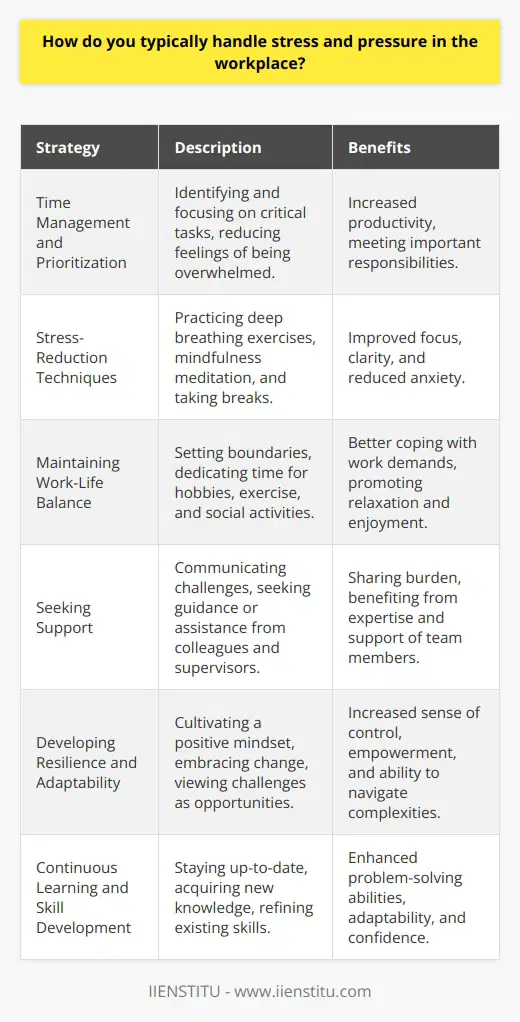
What strategies do you employ to manage stress and maintain productivity during high-pressure situations?
Effective stress management is crucial for maintaining productivity and well-being during high-pressure situations. Several strategies can be employed to navigate these challenging circumstances successfully.
Prioritization and Time Management
One of the most important strategies is prioritizing tasks and managing time effectively. This involves identifying the most critical tasks and allocating sufficient time to complete them. Breaking larger tasks into smaller, manageable steps can also help reduce overwhelm and increase productivity.
Create a prioritized to-do list
Make a list of all the tasks that need to be accomplished. Assign priority levels to each task based on urgency and importance. Focus on completing the high-priority tasks first before moving on to less critical ones.
Use time-blocking techniques
Allocate specific time blocks for different tasks or activities. This helps maintain focus and ensures that sufficient time is dedicated to each task. Be sure to include breaks between time blocks to avoid burnout.
Stress-Reduction Techniques
Incorporating stress-reduction techniques into daily routines can help manage the physical and mental effects of high-pressure situations. These techniques can include deep breathing exercises, meditation, or engaging in relaxation activities.
Practice deep breathing exercises
When feeling stressed, take a few minutes to focus on deep breathing. Inhale slowly through the nose, hold for a few seconds, and exhale through the mouth. Repeat this process several times to promote relaxation and reduce stress levels.
Engage in regular physical activity
Exercise is a powerful stress-reducer. Engage in physical activities you enjoy, such as walking, jogging, or yoga. Regular exercise helps release endorphins, improves mood, and increases overall resilience to stress.
Support Systems and Communication
Building a strong support system and maintaining open communication channels are essential for managing stress during high-pressure situations. Seeking support from colleagues, friends, or family members can provide a sense of connection and help alleviate stress.
Communicate with your team
When working on a team project, maintain clear and open communication with your teammates. Discuss challenges, share progress updates, and collaborate to find solutions. Effective communication helps ensure everyone is on the same page and reduces misunderstandings that can lead to additional stress.
Seek support when needed
Don't hesitate to reach out for help when feeling overwhelmed. Talk to a trusted colleague, friend, or family member about your concerns. Sometimes, simply discussing your challenges can provide a fresh perspective and help you find new ways to cope with stress.
Mindset and Perspective
Maintaining a positive mindset and keeping a healthy perspective are crucial for navigating high-pressure situations. Reframing challenges as opportunities for growth and learning can help reduce stress and increase motivation.
Practice gratitude
Take time each day to reflect on the things you are grateful for. Focusing on positive aspects of your life can help shift your perspective and reduce stress levels. Keep a gratitude journal or share your appreciation with others.
Celebrate small victories
Acknowledge and celebrate small victories along the way. Recognizing progress and accomplishments, no matter how small, can boost motivation and provide a sense of achievement, even in high-pressure situations.
By implementing these strategies consistently, individuals can effectively manage stress and maintain productivity during high-pressure situations. Remember, stress management is an ongoing process that requires practice and patience. Be kind to yourself and recognize that it's okay to take breaks and prioritize self-care when needed.
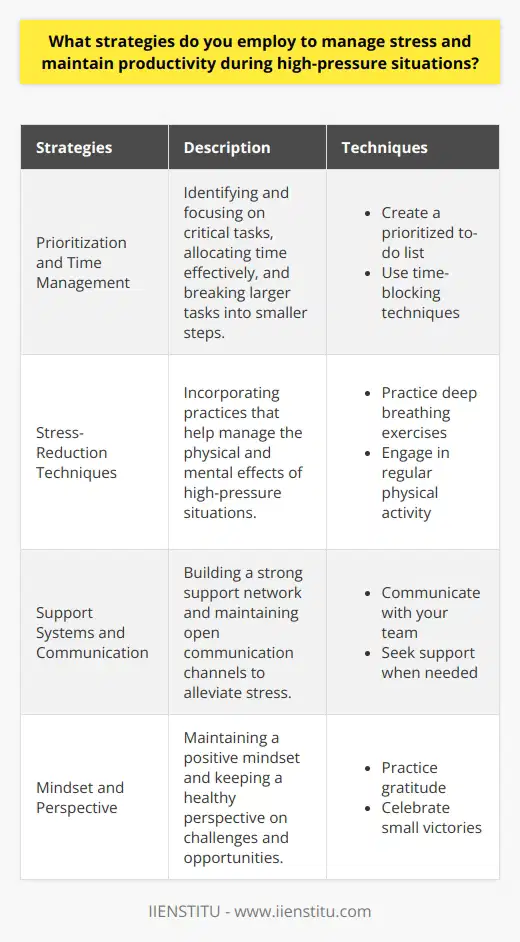
Can you describe a time when you successfully navigated a stressful situation at work and how you approached it?
Navigating stressful situations at work requires a combination of problem-solving skills, emotional intelligence, and effective communication. One instance where I successfully handled a high-pressure scenario was when our team faced a tight deadline for a critical project. The client had suddenly requested additional features, putting our timeline at risk.
Assessing the Situation
I quickly realized that panicking would only worsen the situation. Instead, I took a step back to assess the challenge objectively. I gathered all the relevant information, including the new requirements and the current progress of our team.
Communicating with the Team
I called a meeting with my team to discuss the situation transparently. We brainstormed potential solutions and identified areas where we could optimize our workflow. By involving everyone in the problem-solving process, we fostered a sense of ownership and collaboration.
Prioritizing and Delegating Tasks
To ensure we met the deadline, I prioritized the tasks based on their importance and dependencies. I allocated resources strategically, assigning tasks to team members based on their strengths and expertise. This approach maximized efficiency and minimized bottlenecks.
Managing Expectations
I proactively communicated with the client to manage their expectations. I explained the challenges we were facing and proposed a realistic timeline for delivering the additional features. By being honest and transparent, I built trust with the client and secured their understanding.
Implementing a Contingency Plan
To mitigate potential risks, I developed a contingency plan. I identified critical milestones and created a buffer for unexpected issues. This proactive approach allowed us to handle minor setbacks without derailing the entire project.
Supporting the Team
Throughout the stressful period, I made sure to support my team members. I regularly checked in with them, offered guidance, and recognized their efforts. By maintaining a positive and supportive work environment, we kept morale high and fostered a sense of camaraderie.
Reflecting and Learning
After successfully delivering the project, I conducted a retrospective with the team. We reflected on the challenges we faced, the strategies that worked well, and the areas where we could improve. This exercise helped us learn valuable lessons and strengthen our problem-solving skills for future situations.
Conclusion
Navigating stressful situations at work requires a proactive approach, effective communication, and a focus on problem-solving. By assessing the situation objectively, collaborating with the team, managing expectations, and implementing contingency plans, I successfully led my team through a challenging project. The experience taught me the importance of resilience, adaptability, and supporting one another in high-pressure environments.
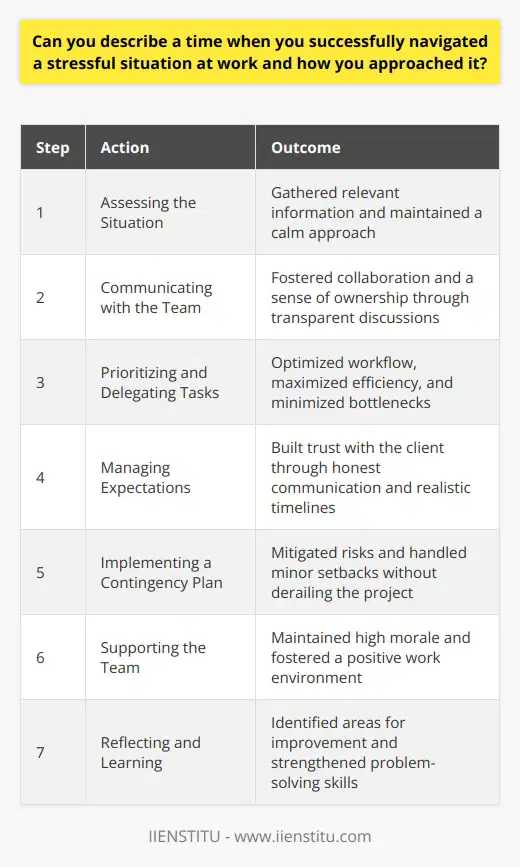
How do you cope with stress and pressure in your workplace?
Coping with stress and pressure in the workplace is crucial for maintaining productivity, well-being, and job satisfaction. Employees can employ various strategies to manage stress effectively and prevent burnout. One key approach is to prioritize tasks and manage time efficiently, ensuring that important responsibilities are addressed promptly. Regular breaks throughout the workday can also help alleviate stress by providing opportunities for mental and physical relaxation.
Effective Communication and Support
Open communication with colleagues and supervisors is essential for managing stress in the workplace. Discussing concerns, seeking guidance, and collaborating with team members can help distribute workload and foster a supportive environment. Additionally, many organizations offer employee assistance programs (EAPs) that provide confidential counseling and resources for managing stress and personal challenges. Utilizing these support systems can be beneficial for employees facing difficult situations or overwhelming pressure.
Maintaining Work-Life Balance
Achieving a healthy work-life balance is critical for reducing stress and preventing burnout. Setting clear boundaries between work and personal life, such as avoiding work-related tasks during off-hours, can help employees recharge and maintain a sense of well-being. Engaging in hobbies, regular exercise, and relaxation techniques like meditation or deep breathing can also promote stress relief and mental clarity. Prioritizing self-care activities and making time for personal interests can significantly improve overall stress management.
Developing Resilience and Adaptability
Building resilience and adaptability is key to coping with stress and pressure in the workplace. Embracing challenges as opportunities for growth and learning can help employees maintain a positive outlook and overcome obstacles. Cultivating a growth mindset, which views setbacks as temporary and encourages continuous improvement, can enhance resilience. Additionally, being adaptable to change and willing to learn new skills can reduce stress associated with evolving job requirements or organizational shifts.
Seeking Professional Help
In some cases, workplace stress may become overwhelming and require professional intervention. Seeking the guidance of a mental health professional, such as a therapist or counselor, can provide individuals with valuable tools and strategies for managing stress and improving overall well-being. Many workplaces also offer stress management workshops or training programs that can equip employees with practical techniques for coping with pressure and maintaining a healthy work-life balance.
By implementing these strategies and prioritizing self-care, employees can effectively manage stress and pressure in the workplace. Creating a supportive work environment, maintaining open communication, and developing personal resilience can contribute to improved job satisfaction, productivity, and overall well-being. Remember, managing stress is an ongoing process that requires consistent effort and self-awareness.
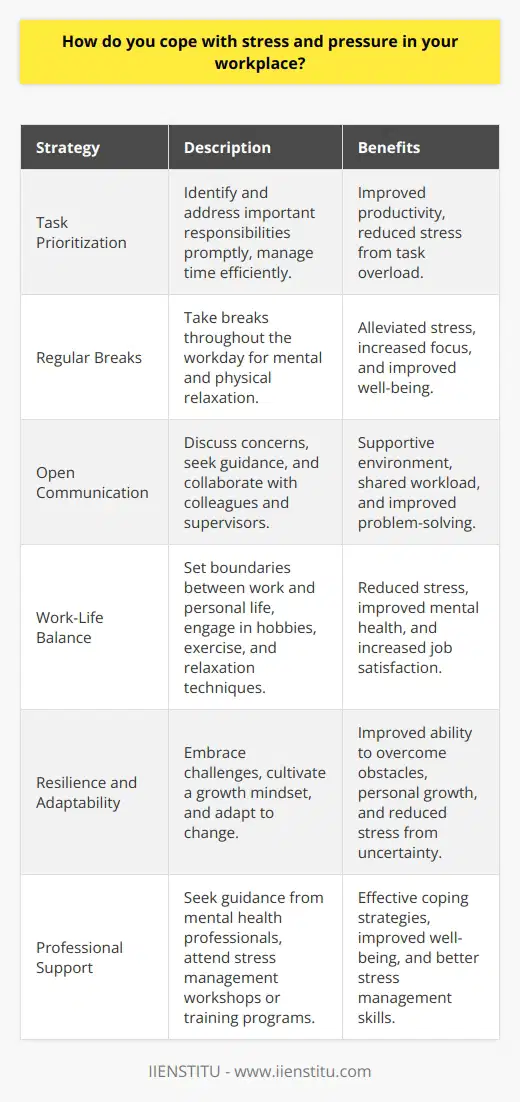
What strategies do you employ to manage stress and pressure in your professional life?
In managing stress and pressure in my professional life, I employ several effective strategies. First and foremost, I prioritize tasks and set realistic goals to avoid overwhelming myself. I break down large projects into smaller, manageable chunks and tackle them one at a time. This approach helps me maintain focus and reduces the likelihood of becoming stressed or anxious.
Time Management Techniques
Effective time management is crucial in minimizing stress and pressure. I use a calendar and a to-do list to keep track of deadlines and responsibilities. By allocating specific time slots for each task, I ensure that I have sufficient time to complete my work without rushing or compromising on quality. Additionally, I set aside dedicated breaks throughout the day to recharge and maintain a healthy work-life balance.
Prioritizing Self-Care
Self-care is an essential aspect of managing stress and pressure. I make sure to engage in regular physical exercise, such as jogging or yoga, to release endorphins and reduce stress levels. Moreover, I prioritize getting enough sleep each night to maintain mental clarity and emotional well-being. By taking care of my physical and mental health, I am better equipped to handle the demands of my professional life.
Effective Communication and Delegation
Open and honest communication with colleagues and supervisors is key to managing stress and pressure. I actively seek support and guidance when needed, and I am not afraid to ask for help or clarification. By fostering positive relationships with my team members, I create a supportive work environment that promotes collaboration and reduces individual stress levels.
Furthermore, I recognize the importance of delegating tasks when appropriate. By assigning responsibilities to team members based on their strengths and abilities, I distribute the workload and alleviate pressure on myself. This approach not only reduces my stress levels but also empowers and motivates my colleagues.
Mindfulness and Stress-Reduction Techniques
Incorporating mindfulness and stress-reduction techniques into my daily routine has proven invaluable in managing pressure. I practice deep breathing exercises and meditation to calm my mind and regain focus. Additionally, I engage in hobbies and activities that bring me joy and provide a much-needed break from work-related stress.
By employing these strategies consistently, I have successfully managed stress and pressure in my professional life. I remain proactive in identifying potential stressors and take appropriate measures to address them before they escalate. By prioritizing my well-being and maintaining a positive outlook, I am able to navigate the challenges of my career with resilience and composure.
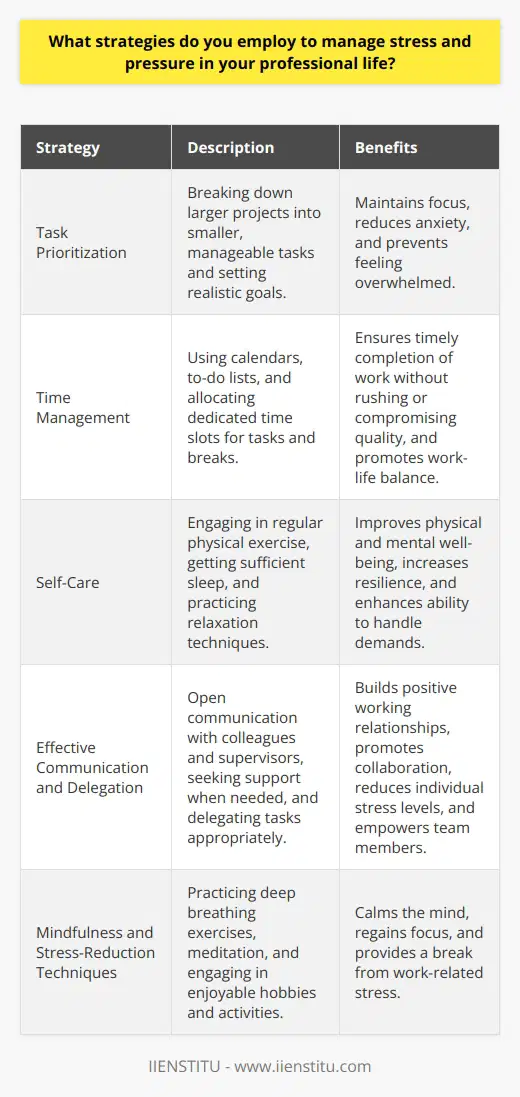
In what ways do you address and handle the stress and pressure that comes with your job?
Stress and pressure are inevitable in any job, but there are several effective ways to manage them. One crucial aspect is maintaining a healthy work-life balance by setting boundaries and prioritizing self-care. This includes taking regular breaks, engaging in physical exercise, and pursuing hobbies outside of work. It's essential to cultivate a support system, both within and outside the workplace, to discuss challenges and seek guidance.
Time Management and Prioritization
Effective time management and prioritization are key to handling job-related stress. Break down large tasks into smaller, manageable steps and create a realistic schedule. Use tools like calendars, to-do lists, and project management software to stay organized. Learn to delegate tasks when appropriate and communicate openly with colleagues and supervisors about workload and deadlines. Regularly assess and adjust priorities to ensure that the most critical tasks are addressed first.
Mindfulness and Stress-Reduction Techniques
Incorporating mindfulness and stress-reduction techniques into your daily routine can significantly help manage pressure. Practice deep breathing exercises, meditation, or yoga to calm the mind and body. These practices can be done in short breaks throughout the day, even at your desk. Engage in activities that promote relaxation, such as listening to music, reading, or spending time in nature. Regularly practicing these techniques builds resilience and improves overall well-being.
Professional Development and Support
Investing in professional development can boost confidence and reduce job-related stress. Attend workshops, seminars, or conferences to enhance your skills and knowledge. Seek mentorship from experienced colleagues or join professional networks to learn from others in your field. Don't hesitate to reach out to your supervisor or HR department for support or guidance when facing challenging situations. Many organizations offer employee assistance programs that provide confidential counseling and resources for managing stress.
Maintaining a Positive Mindset
Cultivating a positive mindset is essential for managing stress and pressure at work. Focus on your strengths and accomplishments rather than dwelling on setbacks. Celebrate small victories and learn from mistakes. Practice gratitude by acknowledging the positive aspects of your job and the support of colleagues. Maintain a growth mindset, viewing challenges as opportunities for learning and development. A positive outlook can help you approach stressful situations with resilience and adaptability.
Healthy Lifestyle Habits
Adopting healthy lifestyle habits is crucial for managing job-related stress. Ensure you get enough quality sleep each night to recharge and maintain focus. Eat a balanced diet rich in fruits, vegetables, and whole grains to support physical and mental well-being. Engage in regular physical activity, as exercise releases endorphins and reduces stress. Limit caffeine and alcohol consumption, as they can exacerbate stress and anxiety. By prioritizing your physical health, you'll be better equipped to handle the demands of your job.
Conclusion
Addressing and handling the stress and pressure that comes with your job requires a multi-faceted approach. By implementing effective time management strategies, practicing mindfulness and stress-reduction techniques, seeking professional support, maintaining a positive mindset, and adopting healthy lifestyle habits, you can successfully navigate the challenges of your job and maintain overall well-being. Remember, it's essential to prioritize self-care and seek help when needed to ensure long-term success and satisfaction in your career.
